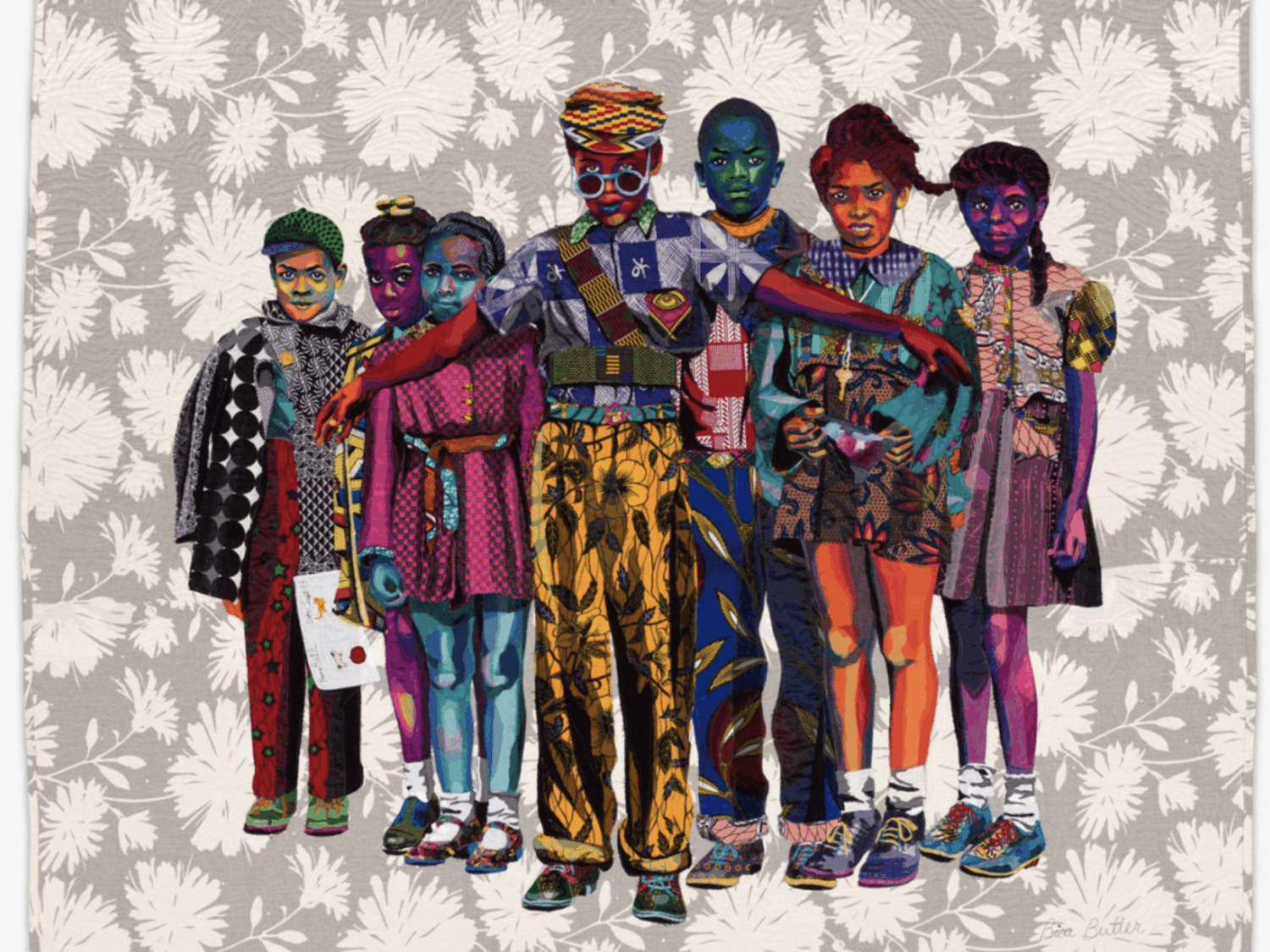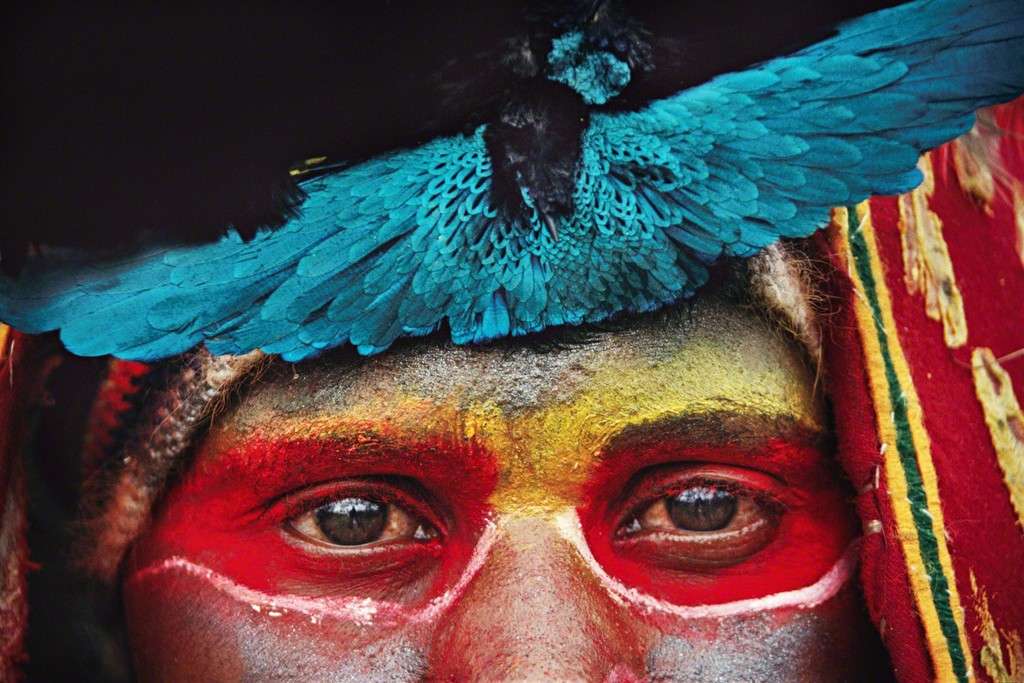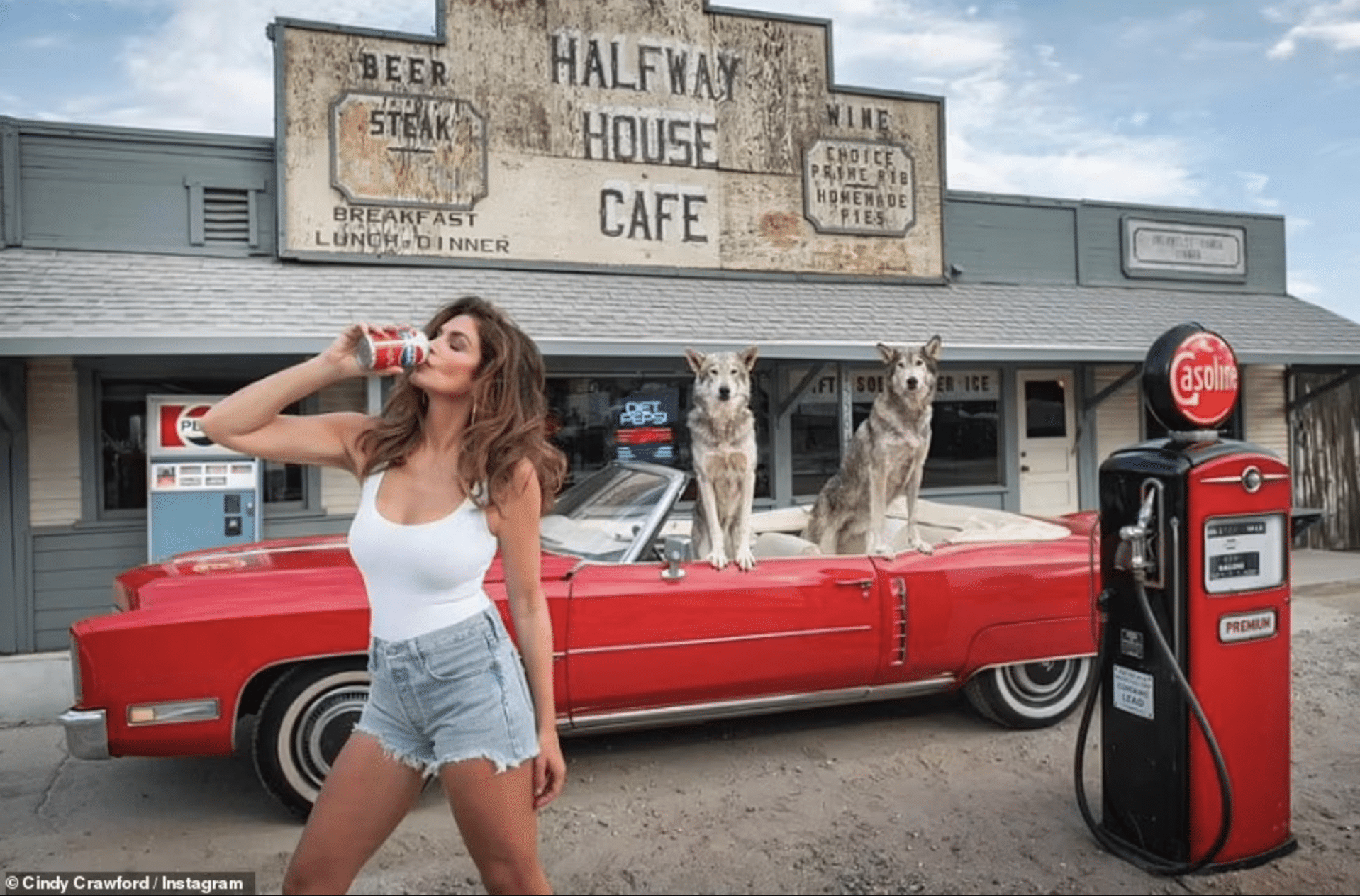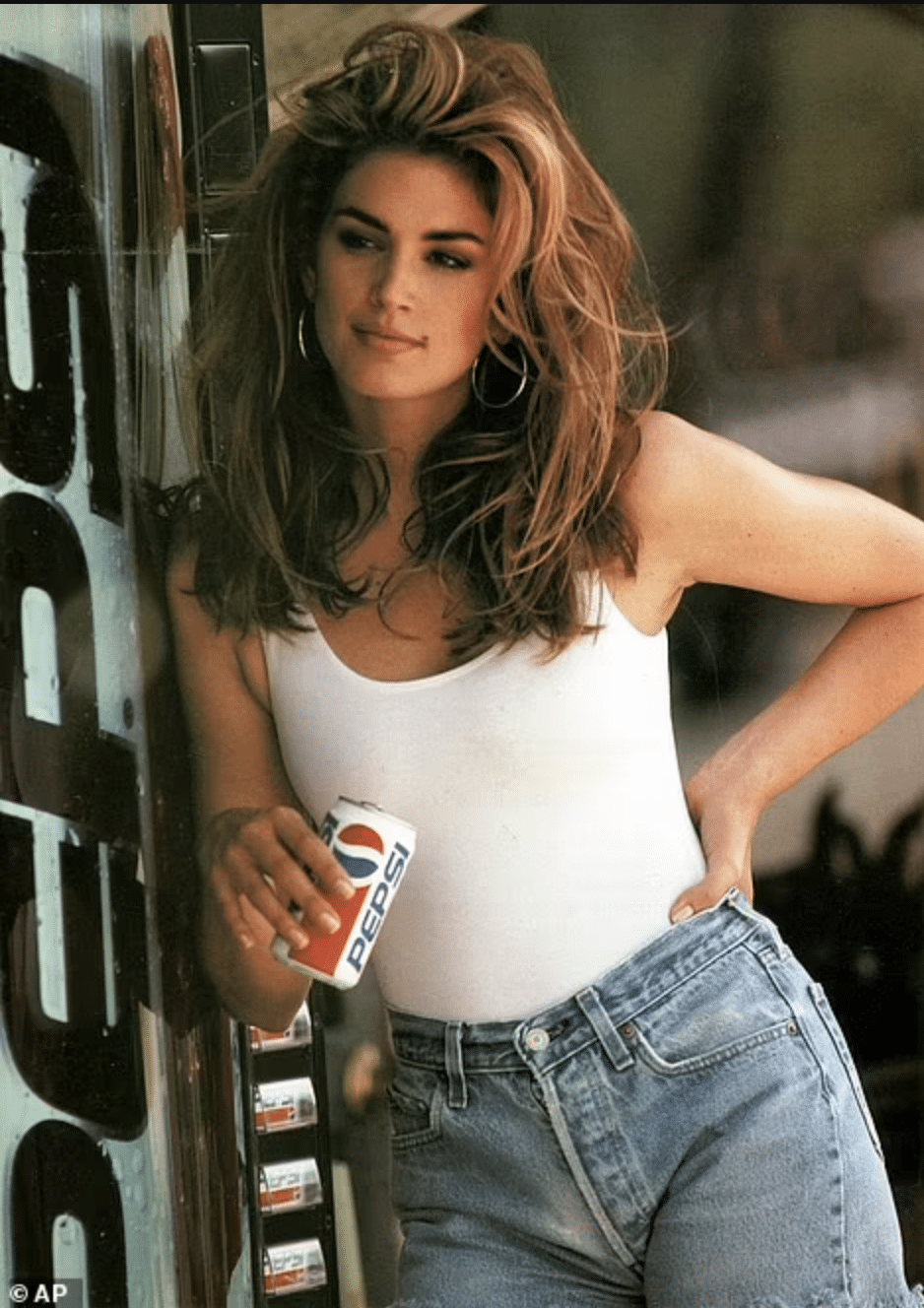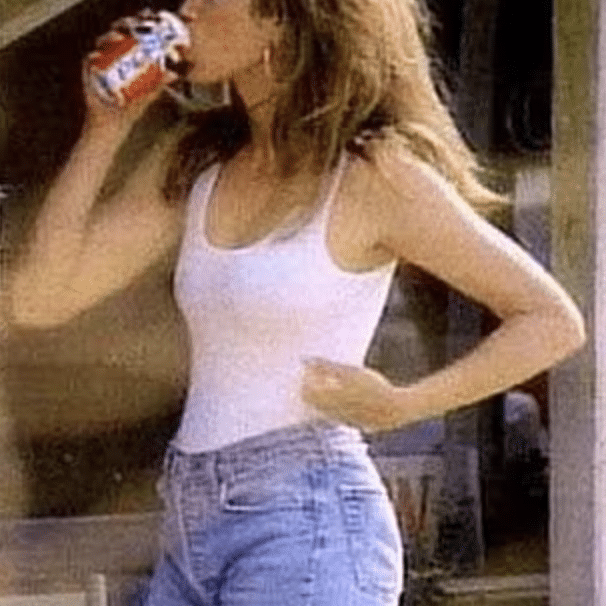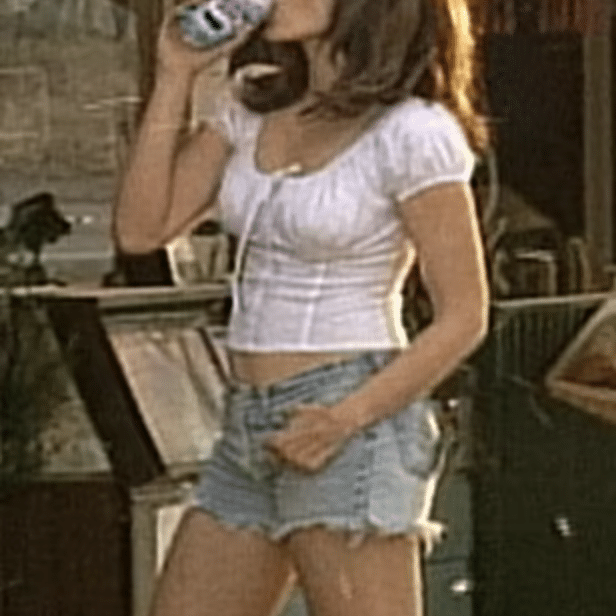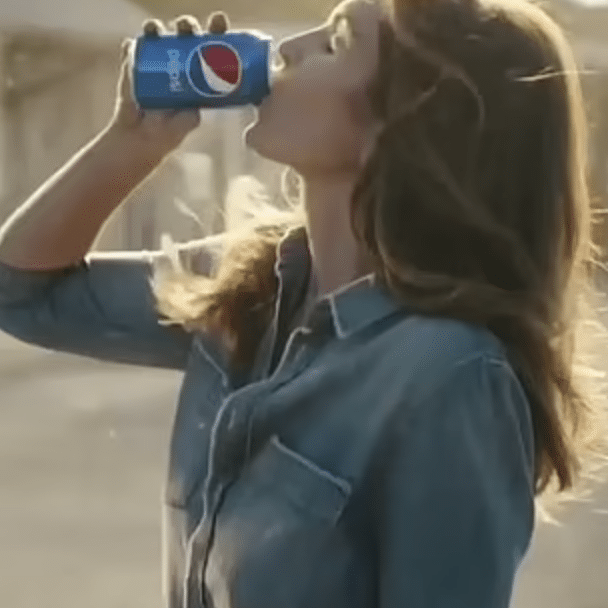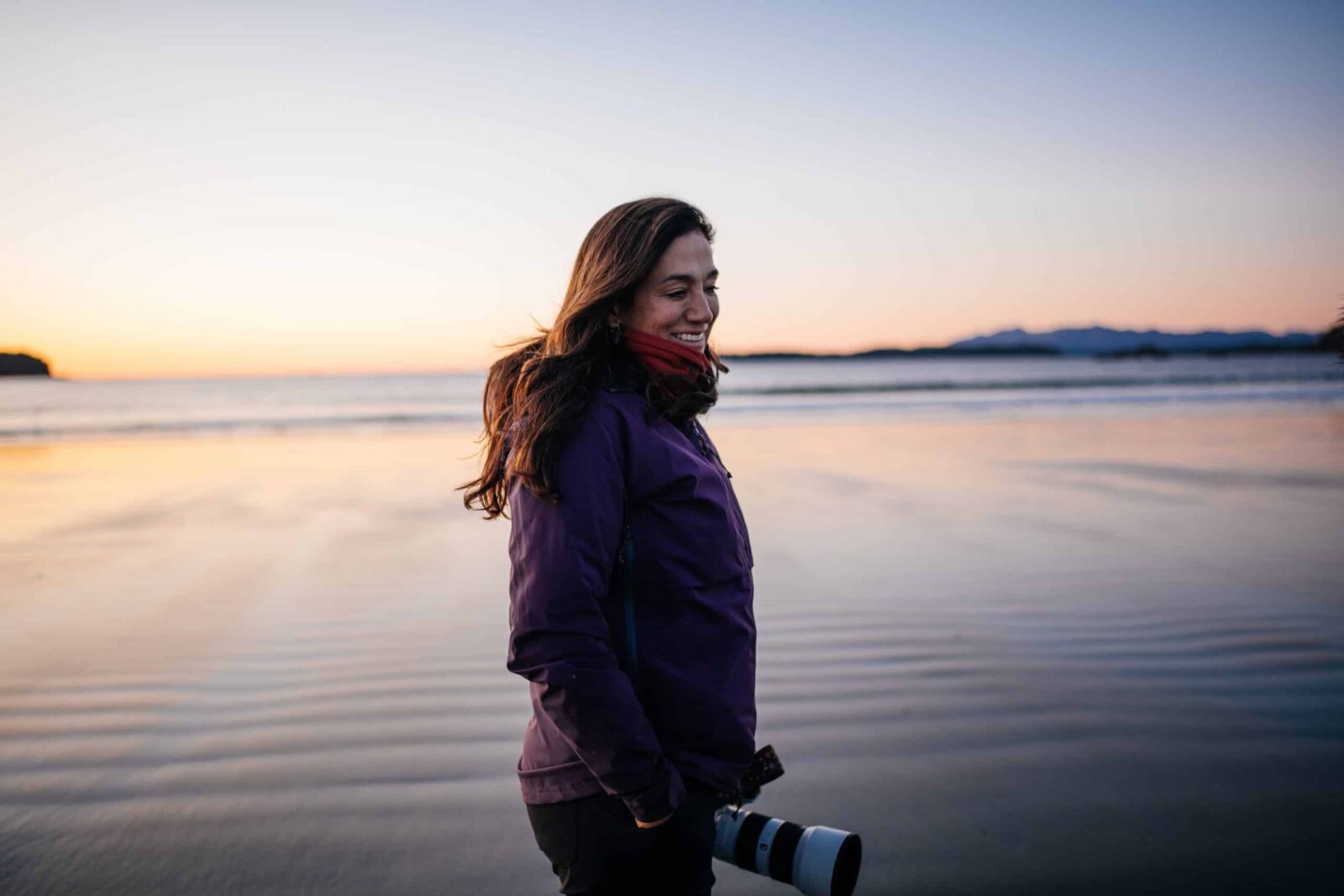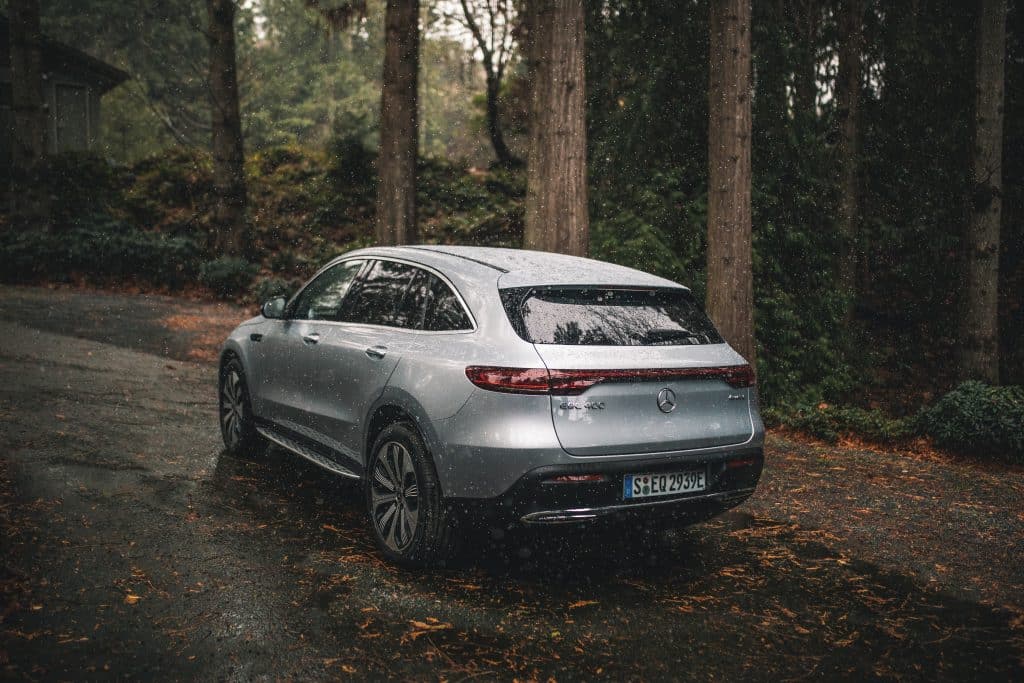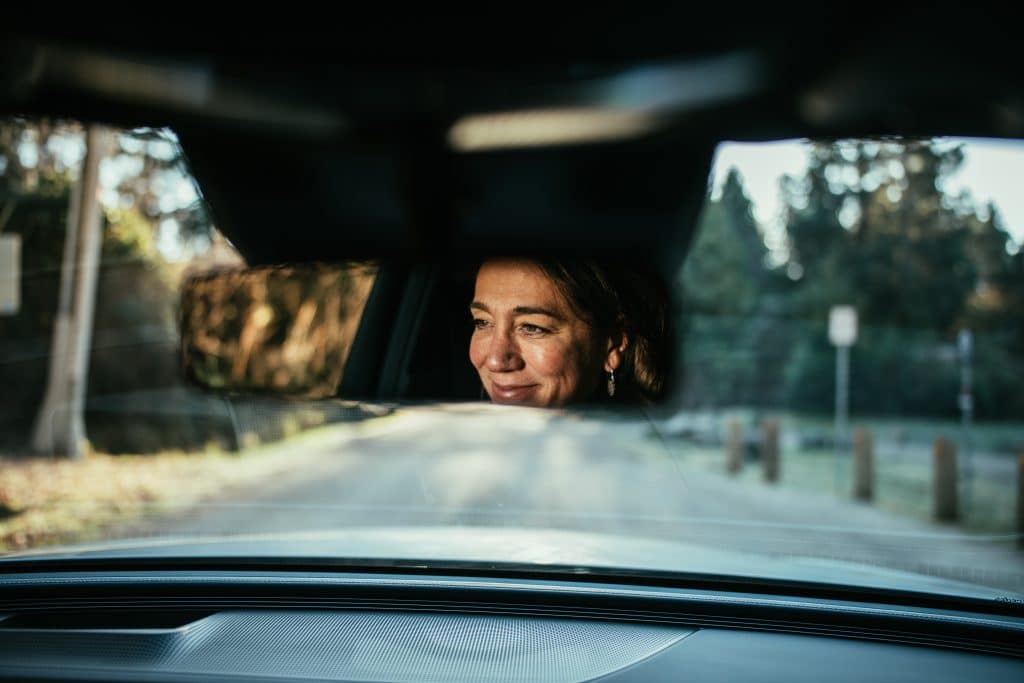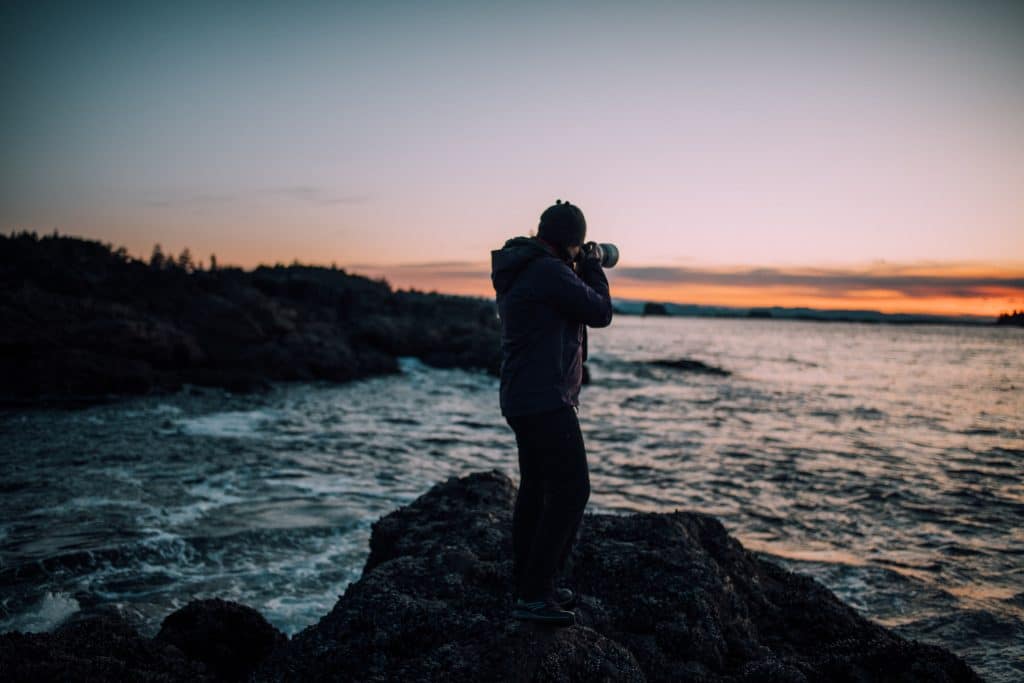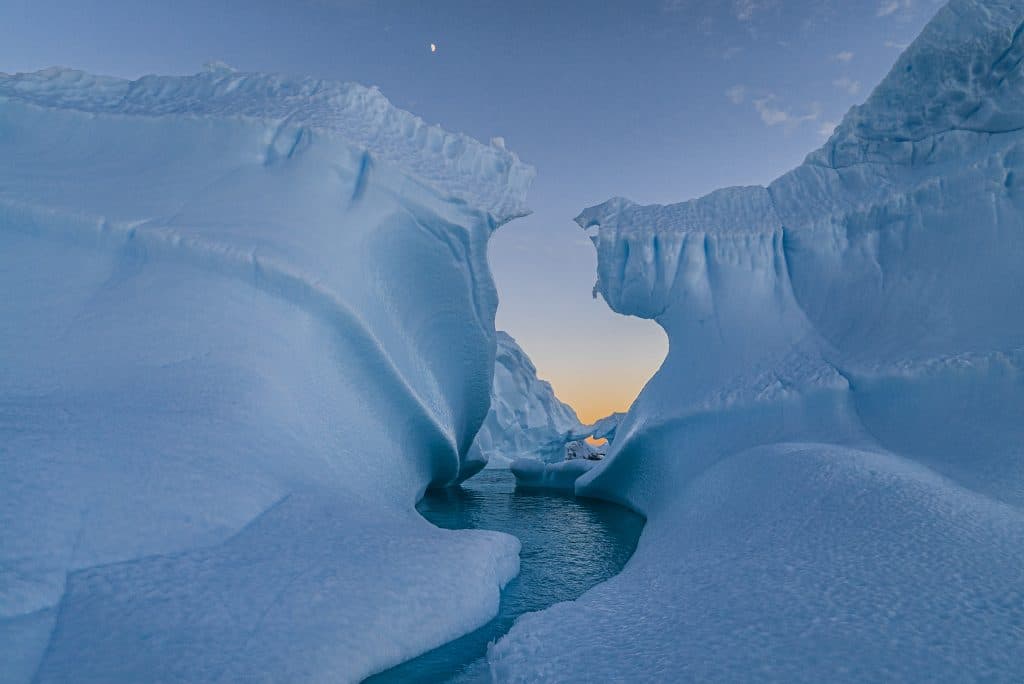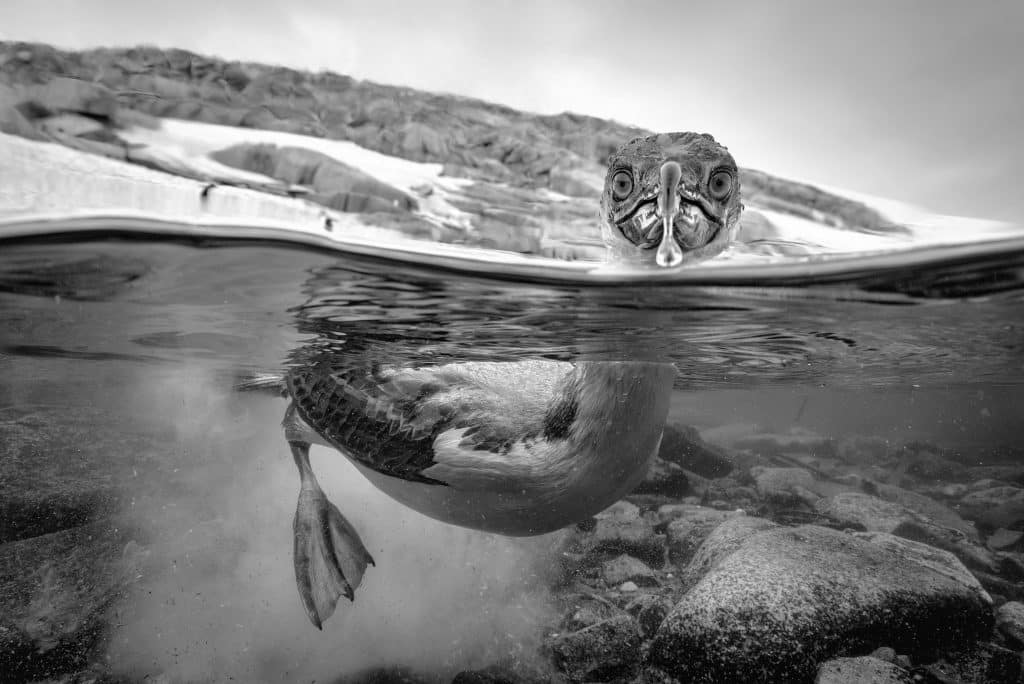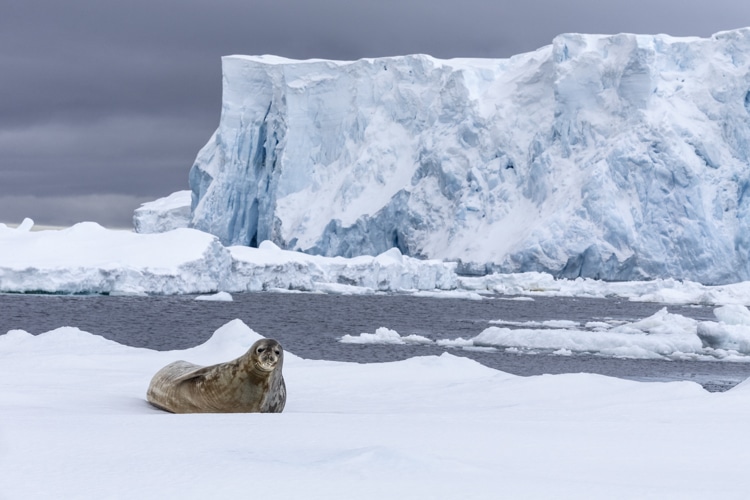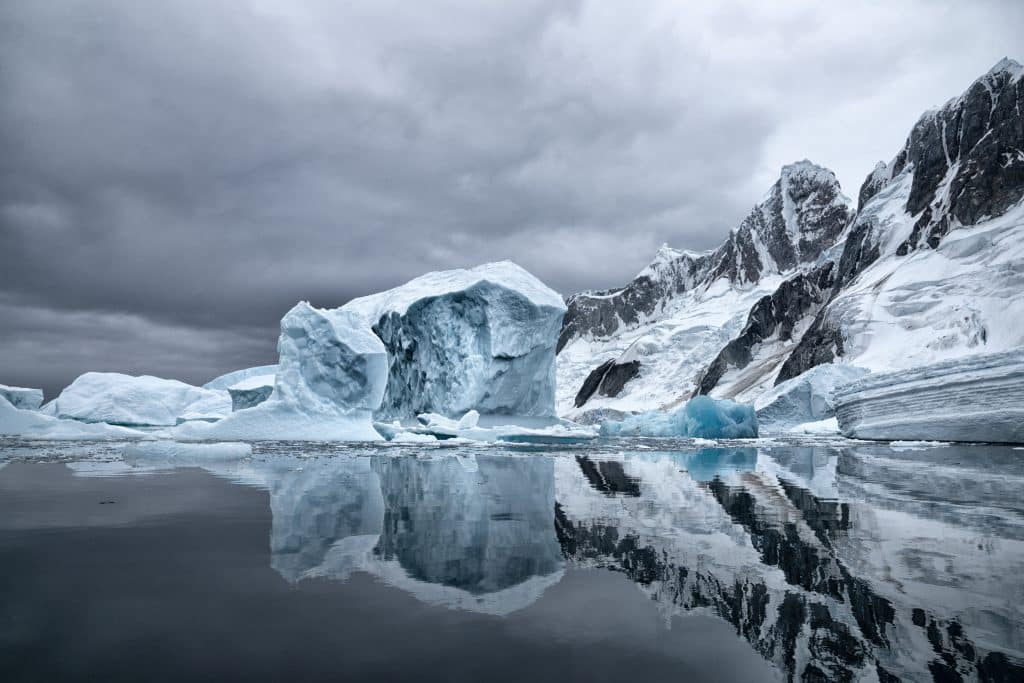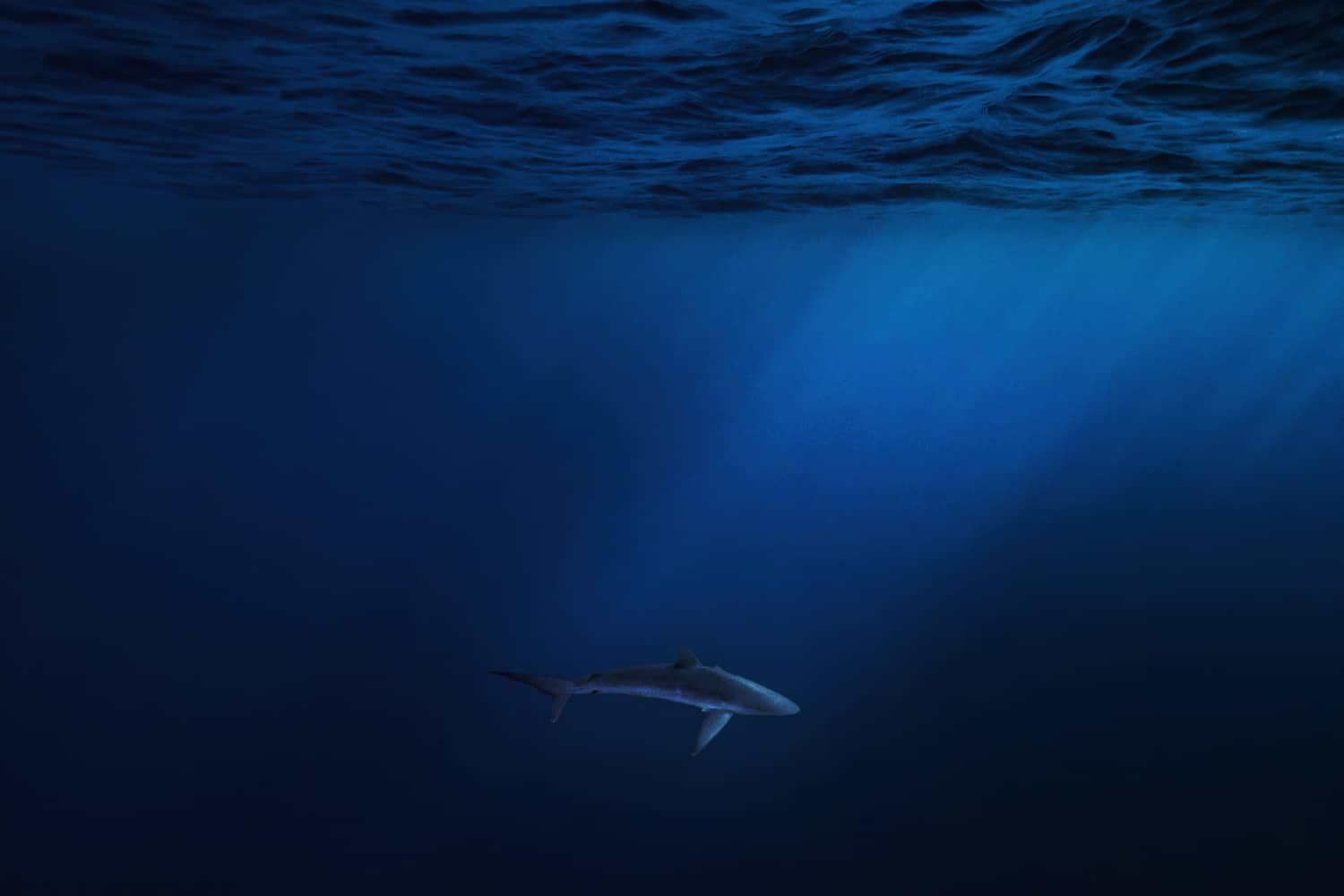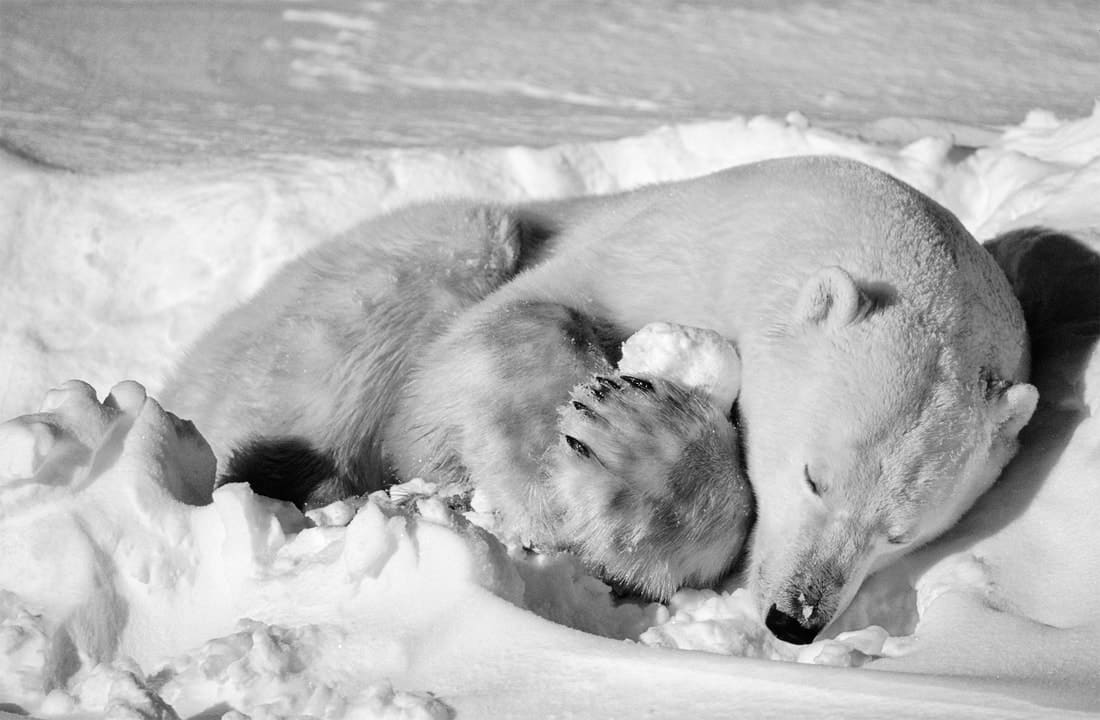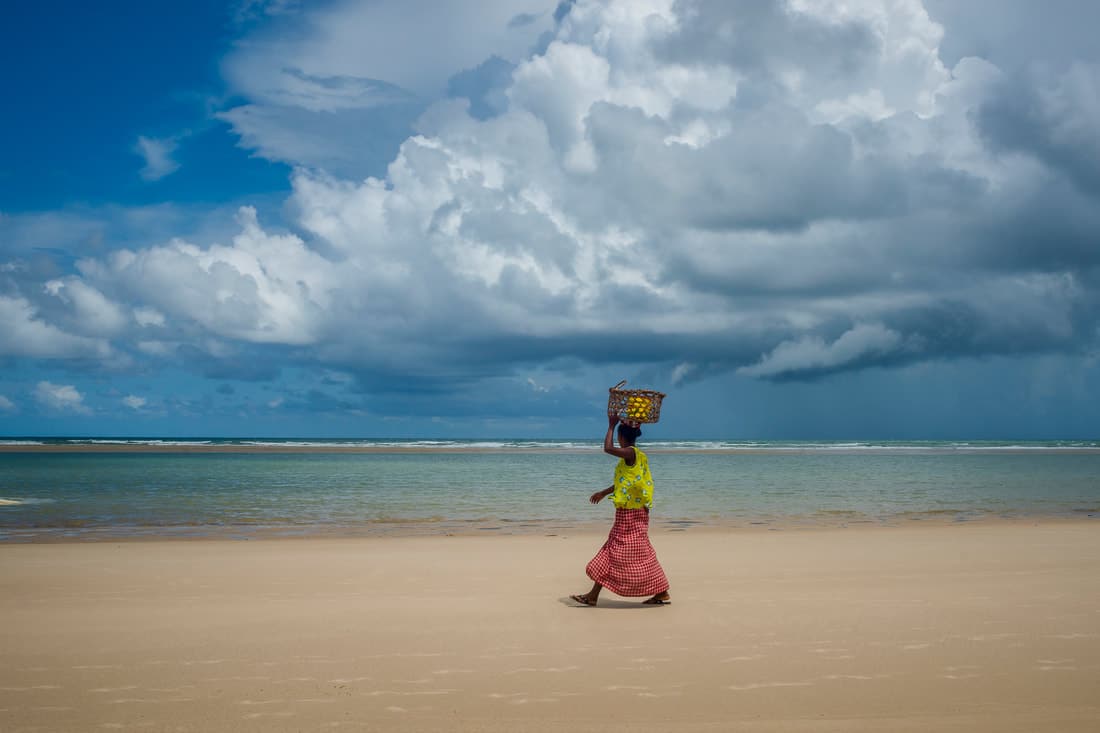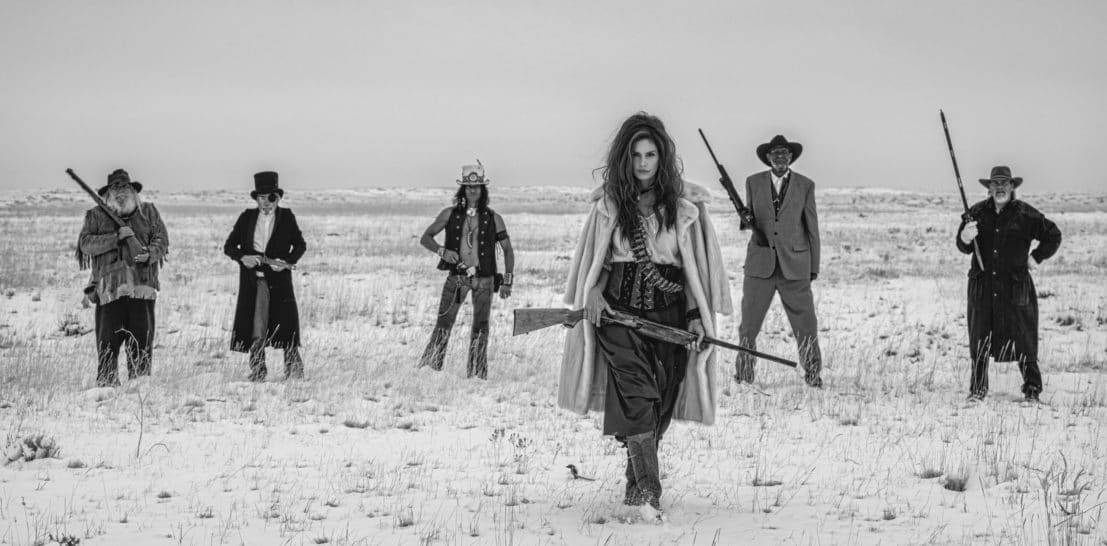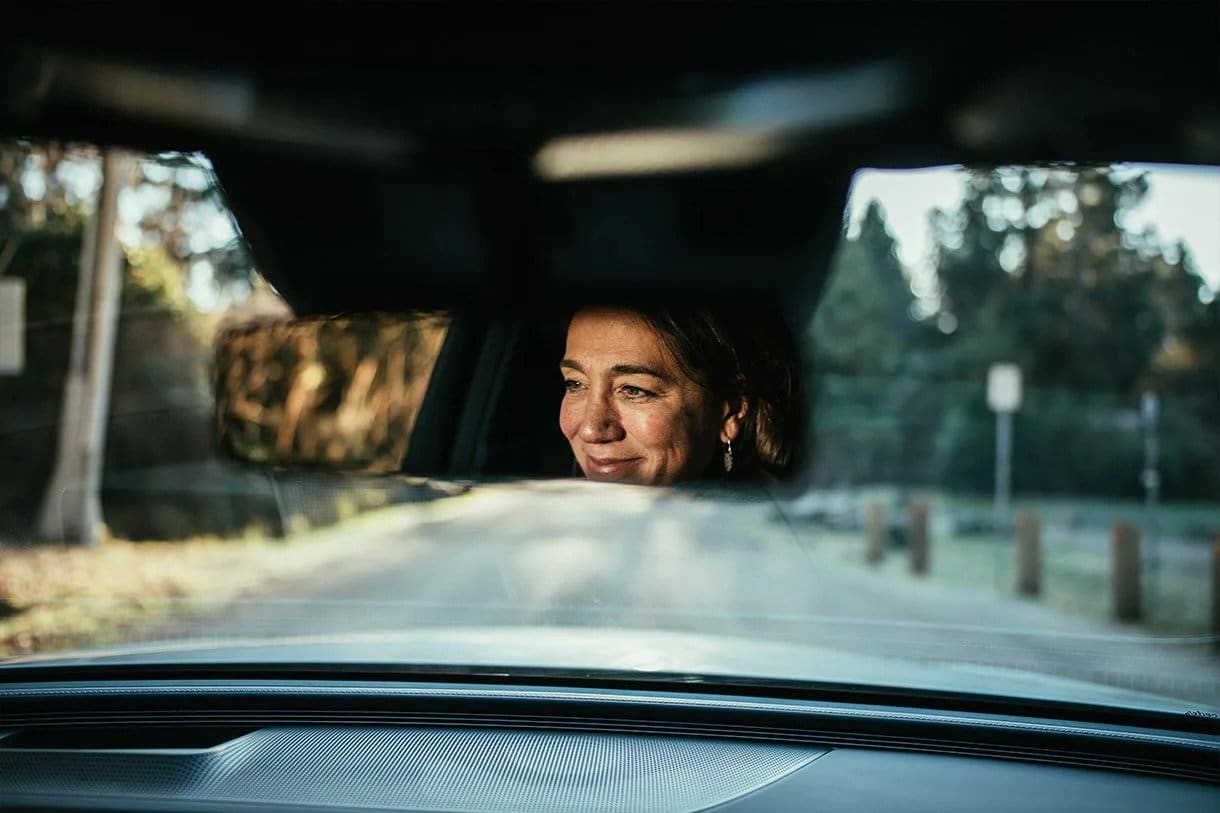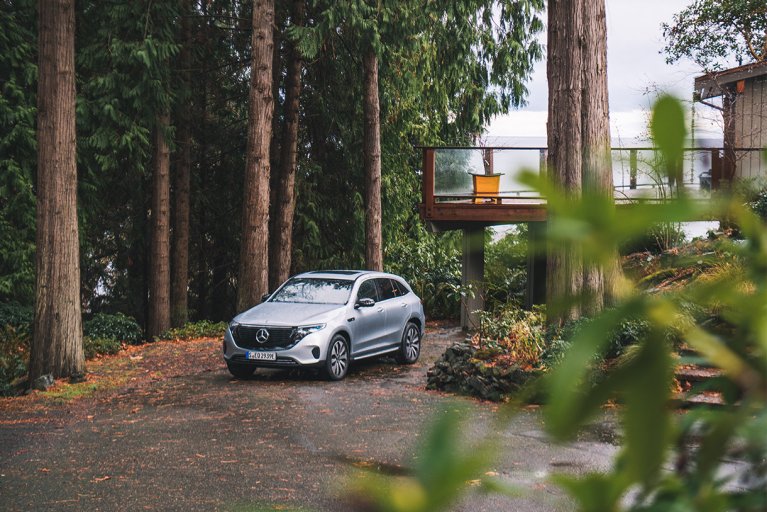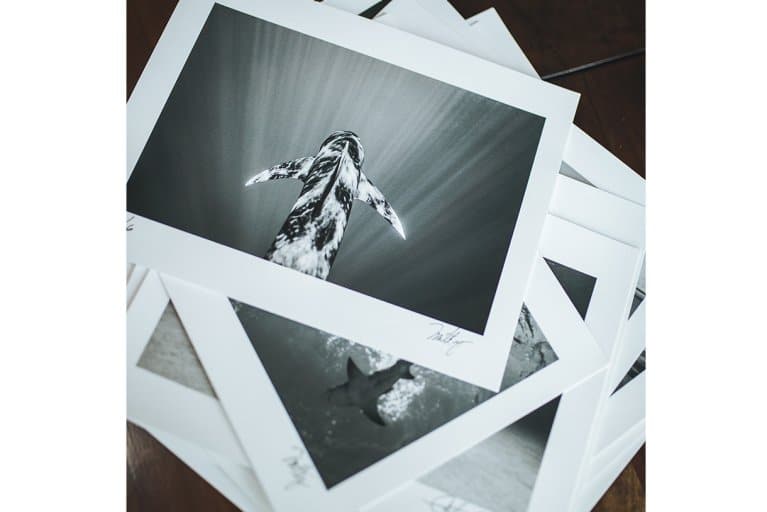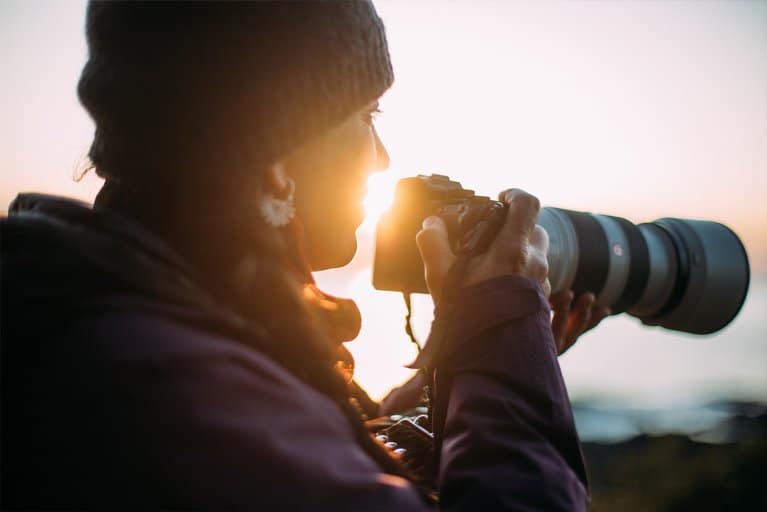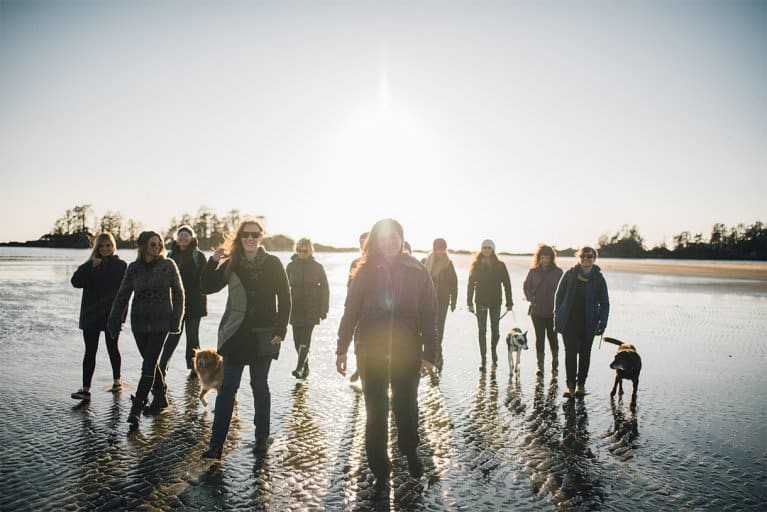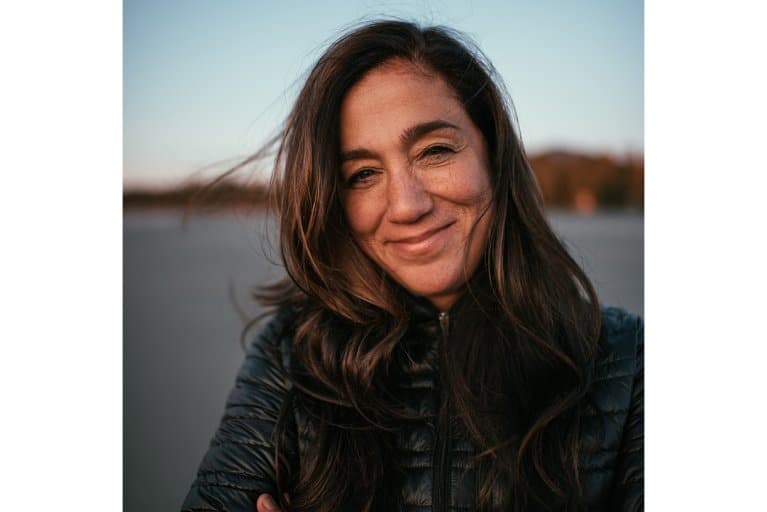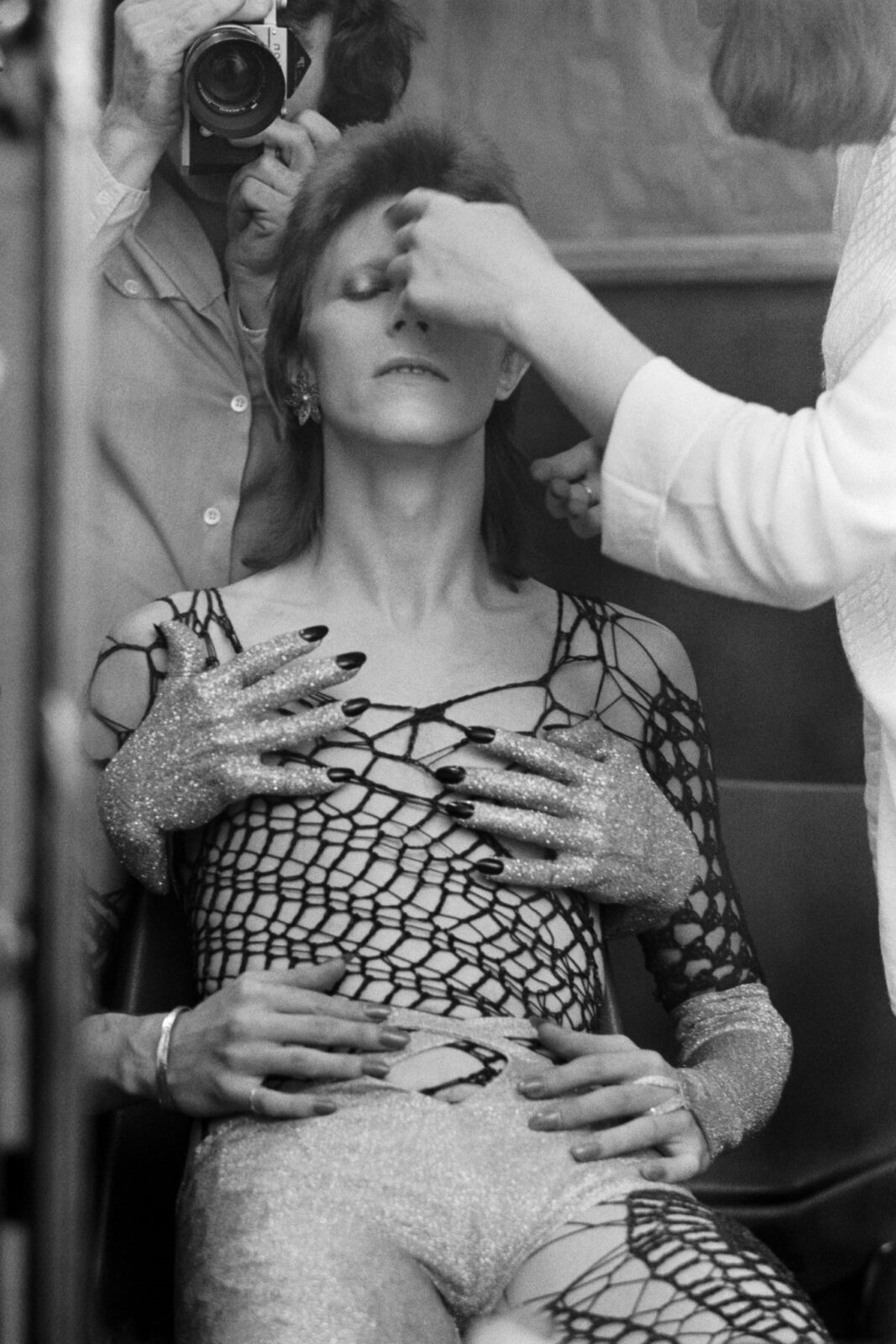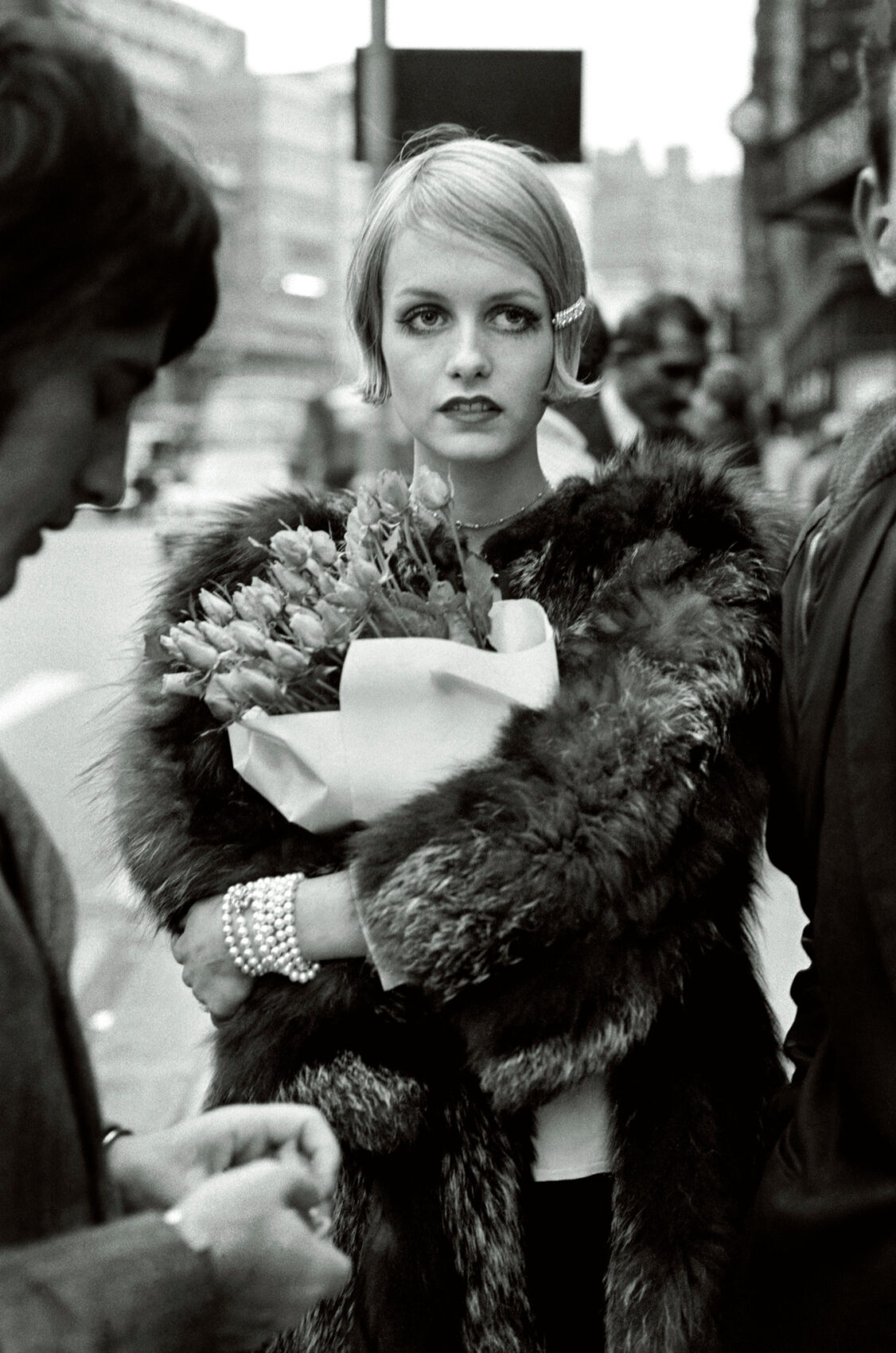News
New David Yarrow exhibit 'Changing Lanes' takes over Hilton | Asmus Contemporary
DeKalb’s very own Cindy Crawford talks recreation of her famous 90s Pepsi commercial
Posted: Oct 11, 2021 / 10:23 AM CDT / Updated: Oct 11, 2021 / 10:27 AM CDT
CHICAGO — A DeKalb-native and one of the world’s biggest supermodel’s was in Chicago over the weekend.
Cindy Crawford, know for fashion, modeling, acting and lots of business enterprises — among them her infamous 1992 Super Bowl Pepsi Commercial was in Bridgeport Saturday night.
Her image in that commercial was recreated by Photographer David Yarrow to raise money for the American Family Children’s Hospital in Madison, Wisc. — where Cindy’s late brother was treated for Leukemia.
Cindy talked to WGN’s Dean Richards about her roots — and the roots of her famous commercial.
News
Artists are putting their stamp on Chicago exhibitions to spread messages of human communication, global conservation, racial discrimination, and gender inequality through a variety of mediums with maximum style.
In her sculpture exhibition “Future Fossils: SUM” (Sept. 7 – Nov. 13), Chicago artist Lan Tuazon shows how the 109 tons of waste produced during a person’s lifetime could be repurposed into a functional home. Built to scale and exhibited inside the two-story gallery at the Hyde Park Art Center, Tuazon presents a one-bedroom house that is constructed solely with recovered materials.
To extend the lifespan of used objects, the artist dissects, layers, and presses them into a stratification-like form that mimics fossils. Visitors are invited to contribute by dropping off plastic items to be shredded on site, which will then be turned into raw materials for sheet press companies. “I had no idea how impactful her work would be on piloting new materials from recovered plastics. This immersive installation will truly put into perspective the geologic weight of our consumer habits, while literally building inhabitable structures from waste,” says Art Center Director of Exhibition & Residency Programs Allison Peters Quinn who curated the show.
In partnership with Chicago’s Department of Cultural Affairs and Special Events, Art on theMART will project works by conceptual artist Barbara Kruger (Sep. 17 – Nov. 25). The installation coincides with the Art Institute of Chicago’s presentation of “Thinking of You. I Mean Me. I Mean You.” (Sep. 19 – Jan 24), a comprehensive exhibition of Kruger’s output. “We are honored to feature the work of such a legendary contemporary artist on our platform,” says Cynthia Noble, Executive Director of Art on theMART. “With this installation, our site extends Kruger’s major retrospective beyond the museum walls and into the urban architectural environment, where the art is free and accessible to all. We are so pleased to collaborate with Kruger and the Art Institute on this significant alignment.”

“For more than four decades, the artist has been a consistent, critical observer of the ways in which images and words circulate through culture and more recently, the accelerated modes in which they inhabit our daily lives. At a time when dispersion has replaced distribution and memes rules the realm of visual information, her momentous installation will invite us to pay attention and carefully consider how we relate to one another,” adds Robyn Farrell, Associate Curator, Modern and Contemporary, Art Institute of Chicago.
Art Institute visitors can also view “Bisa Butler: Portraits” (through Sep. 6). This marks the first solo museum exhibition of the artist’s work which uses the traditionally marginalized medium of textiles and quilts to convey personal and historical narratives of the Black experience. “In my work I am telling the story — this African American side — of the American life,” says Butler. “History is the story of men and women, but the narrative is controlled by those who hold the pen.”
On Aug. 27, Hilton | Asmus Contemporary opens its doors for an opening event at 5 p.m. to kick off “Origins” — an exhibition of images by acclaimed National Geographic photographers/filmmakers Cristina Mittermeier and Paul Nicklen, both of whom are co-founders of Sea Legacy.
“The whole premise of Sea Legacy is that we’re experts at visual communication, and we’re going to be partnering with like-minded organizations that have the same mission that we do, to save the oceans,” explains Mittermeier. “The ocean is the largest ecosystem on our planet, and three billion people depend on coastal and marine resources.” As a ‘National Geographic Woman of Impact’, Mittermeier has worked in more than 100 countries on every continent to connect with an estimated 2.5 billion people about global climate change.
“We have decided to make 2021 our year of conservation. By this, I mean every single sale we make in our gallery this year will benefit a variety of conservation organizations, including organizations that support animals, oceans and other natural resources, in addition to our ongoing support of women’s and children’s causes,” says Arica Hilton, global advocate and Hilton | Asmus Contemporary founder. “Through the arts, Hilton | Asmus Contemporary is dedicated to making every single step and every breath we take, have a purpose. A global purpose. A higher purpose. We will be working with artists who search for solutions addressing the plight of our environment and the human condition.”
Paintings and mixed media works by Swedish artist Anna U Davis are showcased in “Reality Check” (through Nov. 28) at Chicago’s Swedish American Museum in Andersonville. The solo exhibition explores gender inequality, racial discrimination and climate change.
The Museum of Contemporary Art Chicago presents “Bani Abidi: The Man Who Talked Until He Disappeared” (Sep. 4 – June 5) showcasing nearly two decades of work by multidisciplinary Pakistani artist Bani Abidi. The artist uses her upbringing in Karachi and experiences while studying at the School of the Art Institute of Chicago to inform her work which satirically critiques those in power. Organized by Sharjah Art Foundation, the exhibition includes video, photography, sound, and installations that explore transcultural connections with humor.
__
First image: Bisa Butler. The Safety Patrol, 2018. Cavigga Family Trust Fund. © Bisa Butler.
Second Image: Untitled (Truth), 2013, Digital image courtesy of Barbara Kruger. ©
September 10, 2021
News
PAUL NICKLEN
Paul Nicklen (Canadian) is a visual artist and marine biologist who has documented both the beauty and the plight of our planet for over 20 years. Paul’s photography informs and connects by creating an emotional bond with wild subjects in extreme conditions.
After a 20-year career of photographing for journalistic publications like National Geographic, Paul’s perpetuating dream is to revisit his archives for the true artistic gems and release them to the world. His ongoing journey is to continue photographing intimate, evocative, powerful subject matter to create a thought-provoking body of work. Paul hopes his viewers look into the eyes of the animals in his photographs and fall in love with their vulnerability.
In addition to being one of the world’s most renowned nature photographers, Paul is a well-known speaker, TED Talks participant, author, and National Geographic Fellow. In the past two decades, Paul has collaborated with scientists, filmmakers, conservationists, and explorers to create awareness and inspire action for global issues such as climate change.
Paul has garnered more than 30 of the highest awards given to any photographer in his field, earning a global following of celebrities, conservationists, and fans.
CRISTINA MITTERMEIER
One of the most respected voices in conservation photography and one of the most influential female photographers in the world, Cristina Mittermeier began her career as a Marine Biologist working in her native Mexico.
For the past twenty-five years, she has dedicated herself to inspiring a global audience to care about the delicate balance between human well-being and healthy ecosystems.
Cristina’s work has exhibited at the Oceanographic Museum of Monaco, The Miller Gallery in Cincinnati, The Paul Nicklen Gallery in New York, Xposure in the UAE , Art Basel Miami, Terras de Salitre/Mar de Mares Festival in Santiago, The Museum of Plastic Pop-Up in New York, The United Nations Headquarters in association with Disney and Girl Up, and at Fotografiska in Stockholm, Sweden.
Cristina is the co-founder of SeaLegacy, the founder and former president of the International League of Conservation Photographers, a board member for the WILD Foundation, an advisor on two major Conservation International programs, an esteemed public speaker, and a recipient of multiple internationally recognized awards for her photography. In 2016, Cristina received the Imaging Award for Photographers who Give Back and in 2018 was acknowledged as a National Geographic Adventurer of the Year.
She is the editor of 26 conservation photography books and her Fine Art Coffee Table book, Amaze, is in its second printing.
Today, Cristina is the Co-founder of the conservation society, SeaLegacy, a National Geographic contributing photographer, a Sony Artisan of Imagery and the editor of 26 coffee table books on conservation issues. She is the first female photographer to reach 1M followers on Instagram and was a 2018 National Geographic Adventurer of the Year. She is acknowledged as one of the most Influential Women in Ocean Conservation in 2018 by Ocean Geographic, and The Men’s Journal recently named her as one of the 18 Most Adventurous Women in the World.
Cristina is a pioneer in the use of powerful and emotive imagery to propel conservation efforts. Born in Mexico, Cristina is a marine biologist, photographer, and writer who specializes in issues surrounding fisheries and indigenous cultures.
September 10, 2021
Cindy Crawford, 55, shows off her age-defying supermodel figure as she slips back into her denim hotpants to recreate her iconic 1992 Pepsi ad
Supermodel Cindy made her first appearance in a Pepsi TV commercial during the 1992 Super Bowl The original featured Cindy wearing a white tank top and blue jean shorts with big hoop earrings on She was driving a Lamborghini and then stops at a gas station for a can of soda which she sucks down And then in 2002 she was asked to appear in a very similar ad, this time for Diet Pepsi Cindy recreated the iconic ad to raise funds for the American Family Children's Hospital in Madison, where her late brother was treated for leukemia Tragically, Jeffery died of childhood leukemia when he was three-years-old
Cindy Crawford lived up to her supermodel status as she slipped back into a white tank top and her blue denim Daisy Duke shorts to recreate her iconic 1992 Pepsi Super Bowl ad.
Taking to Instagram on Tuesday, the catwalk queen, 55, showed off her age-defying figure in the photoshoot, taken by photographer David Yarrow, to raise funds for the American Family Children’s Hospital in Madison, Wisconsin, where her late brother Jeff was treated for leukemia.
Posing by a red vintage car, Cindy wowed as she once again donned silver hoop earrings and styled her hair into a big bouncy blow out.
The shoot was set at the Halfway House Cafe, where Cindy shot the famous commercial. Two wolves sat in the retro supercar as Cindy fuelled up on gas.
Crawford shared what the new Pepsi experience was like. ‘It’s always a pleasure and a thrill to work with my friend @davidyarrow,’ began the Versace model.
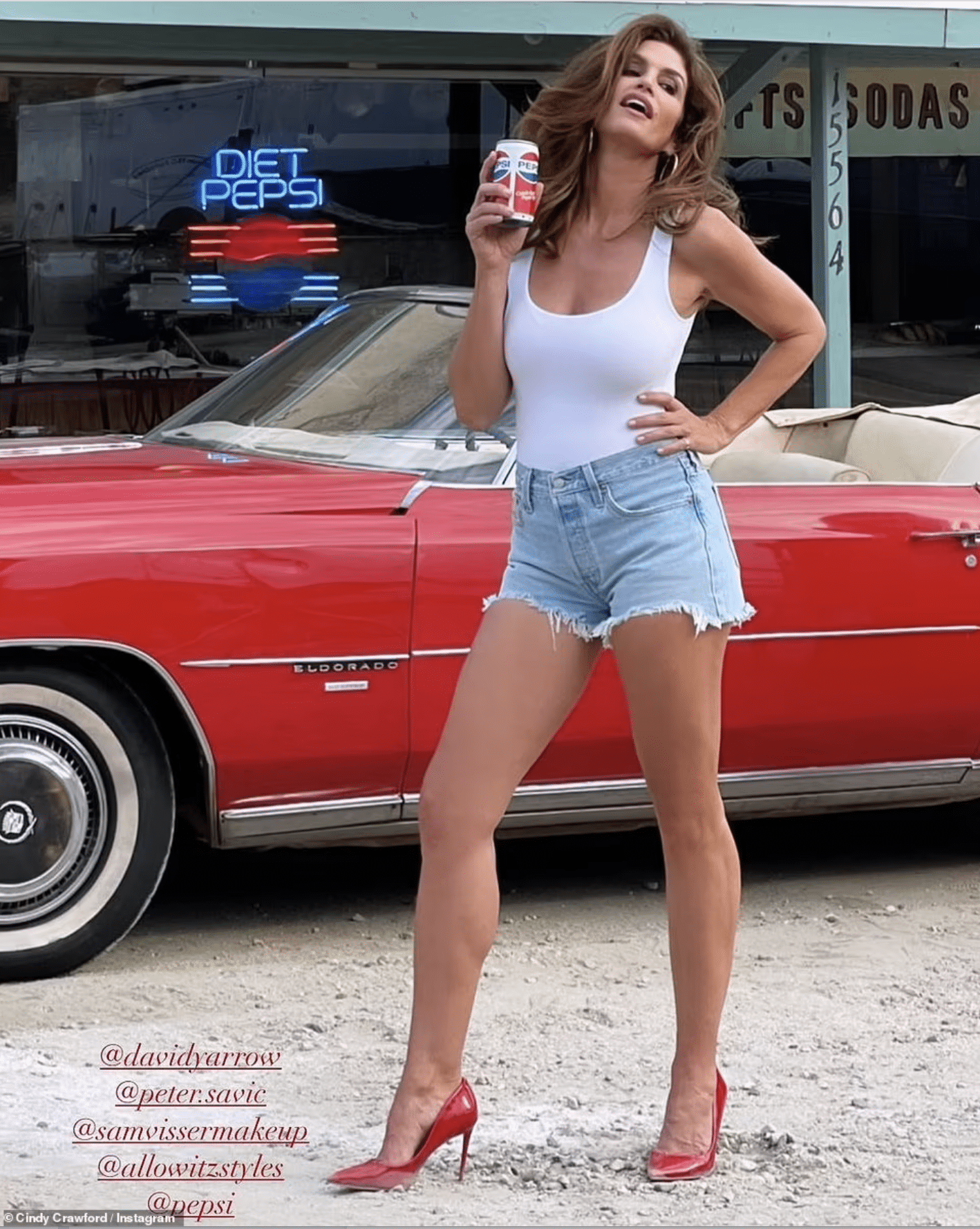
Wow: Taking to Instagram on Tuesday, the catwalk queen, 55, showed off her age-defying figure in the photoshoot, taken by photographer David Yarrow, to raise funds for the American Family Children’s Hospital in Madison, Wisconsin
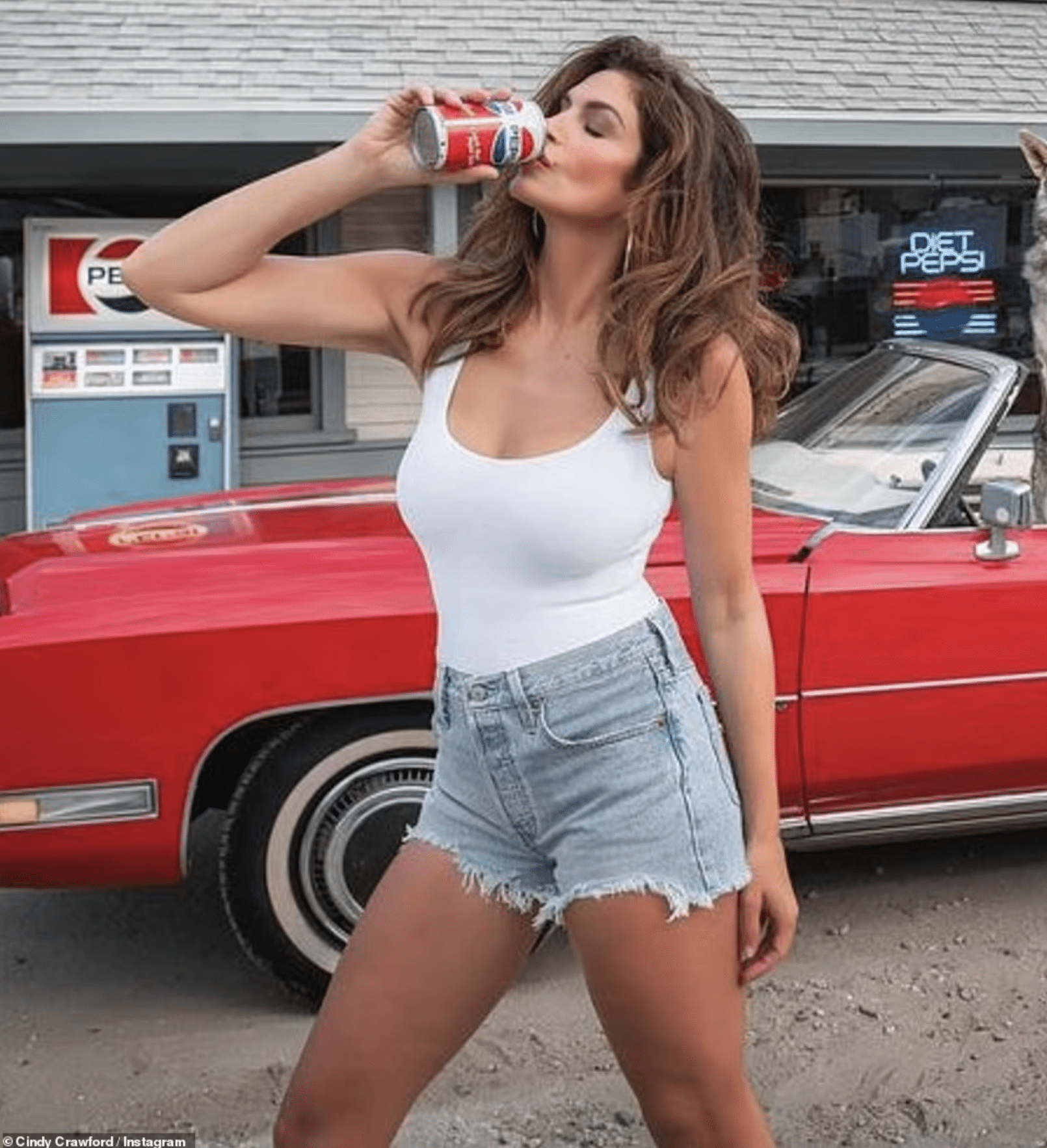
Strike a pose: Slipping into a pair of red stiletto heels, Cindy looked just as good as she did in 1992 as she displayed toned arms, long legs and very small waistline in the tiny shorts and low-scoop vest
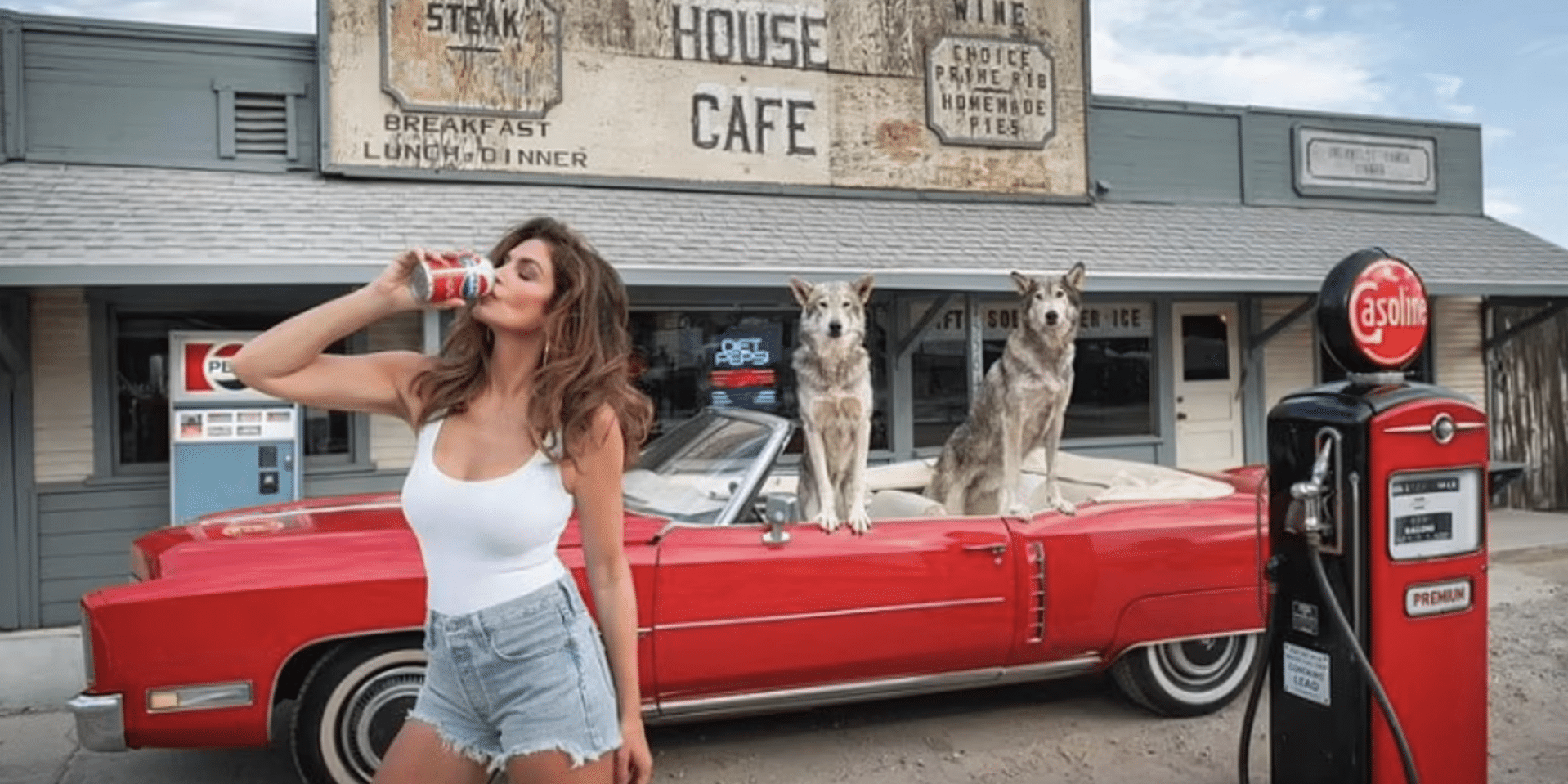
Her pack: The shoot was set at the Halfway House Cafe, where Cindy shot the famous commercial. Two wolves sat in the retro supercar as Cindy fuelled up on gas
‘And even more so when it’s for a good cause. We returned back to the original Halfway House from the famous @pepsi commercial I did in 1992 to recreate the moment (with a David Yarrow twist) in hopes of raising funds for the American Family Children’s Hospital in Madison Wisconsin where my brother was treated for leukemia.’
Crawford was born in DeKalb, Illinois, and raised with her two sisters, Chris and Danielle. Their brother Jeffery died of childhood leukemia at age three.
Cindy continued: ‘So far, with the help of David’s gallery network across the globe supporting the art and its sales — we’ve already raised 1 million dollars for the cause.’
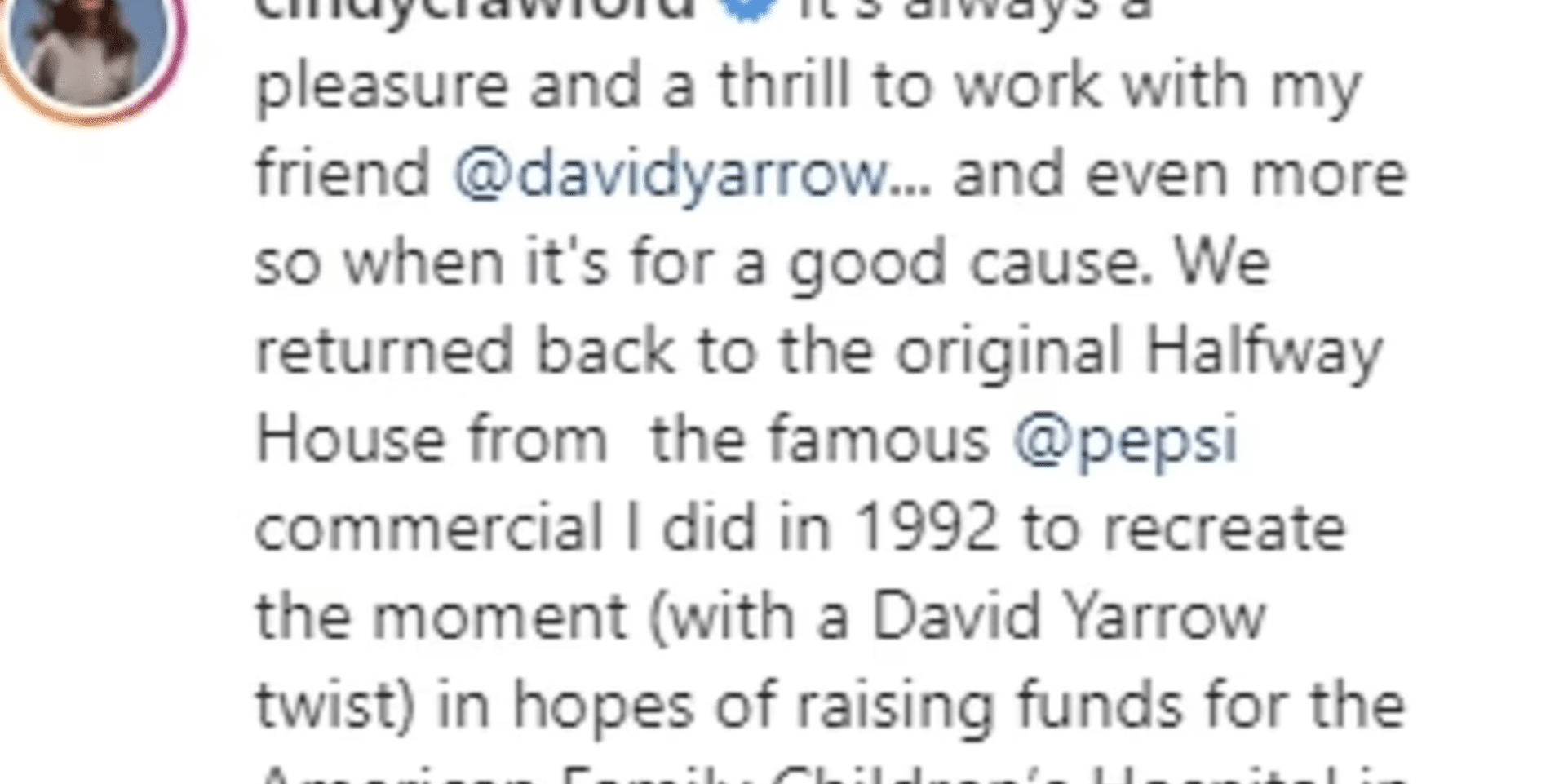

Important cause: Crawford wants to raise funds to help the hospital where her late brother Jeffery was treated for childhood leukemia. He tragically died aged three

She is generous: Crawford shared what the new Pepsi experience was like. ‘It’s always a pleasure and a thrill to work with my friend @davidyarrow,’ began the Versace model

Close to her heart: ‘And even more so when it’s for a good cause. We returned back to the original Halfway House from the famous @pepsi commercial I did in 1992 to recreate the moment (with a David Yarrow twist) in hopes of raising funds’
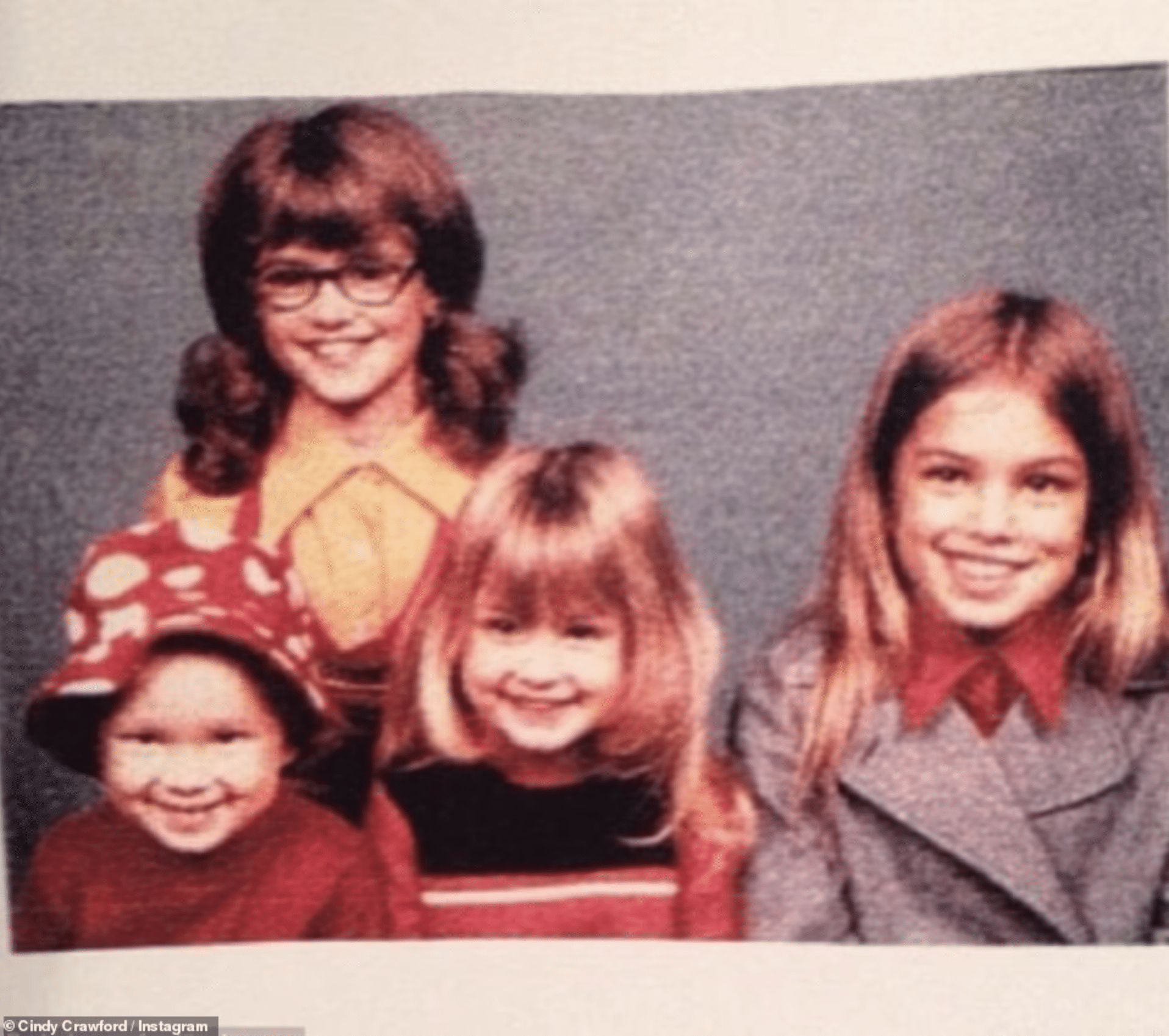
Devastating: Crawford (right) was born in DeKalb, Illinois, and raised with her two sisters, Chris and Danielle. The family tragically lost their brother Jeff when he was three
She then credited the members of her glam squad.
‘I also have to thank my dear friend, hairstylist @peter.savic who did the iconic hair for the original commercial… so i was thrilled he was able to be here for this version as well!’ said the wife of Rande Gerber.
‘Thanks also to @samvissermakeup for makeup and @allowitzstyles for styling. I think we nailed it! Such a fun day –– I can’t wait to show you more. More on stories xo.’
Stars praised her move. Reese Witherspoon said, ‘Truly gorgeous ! And for a great cause ❤️.’ Helena Christensen said, ‘❤️cool in every way.’
Thrice before: Cindy seen far left in 1992, then in another ad in 2002 and on the far right she is seen in 2018
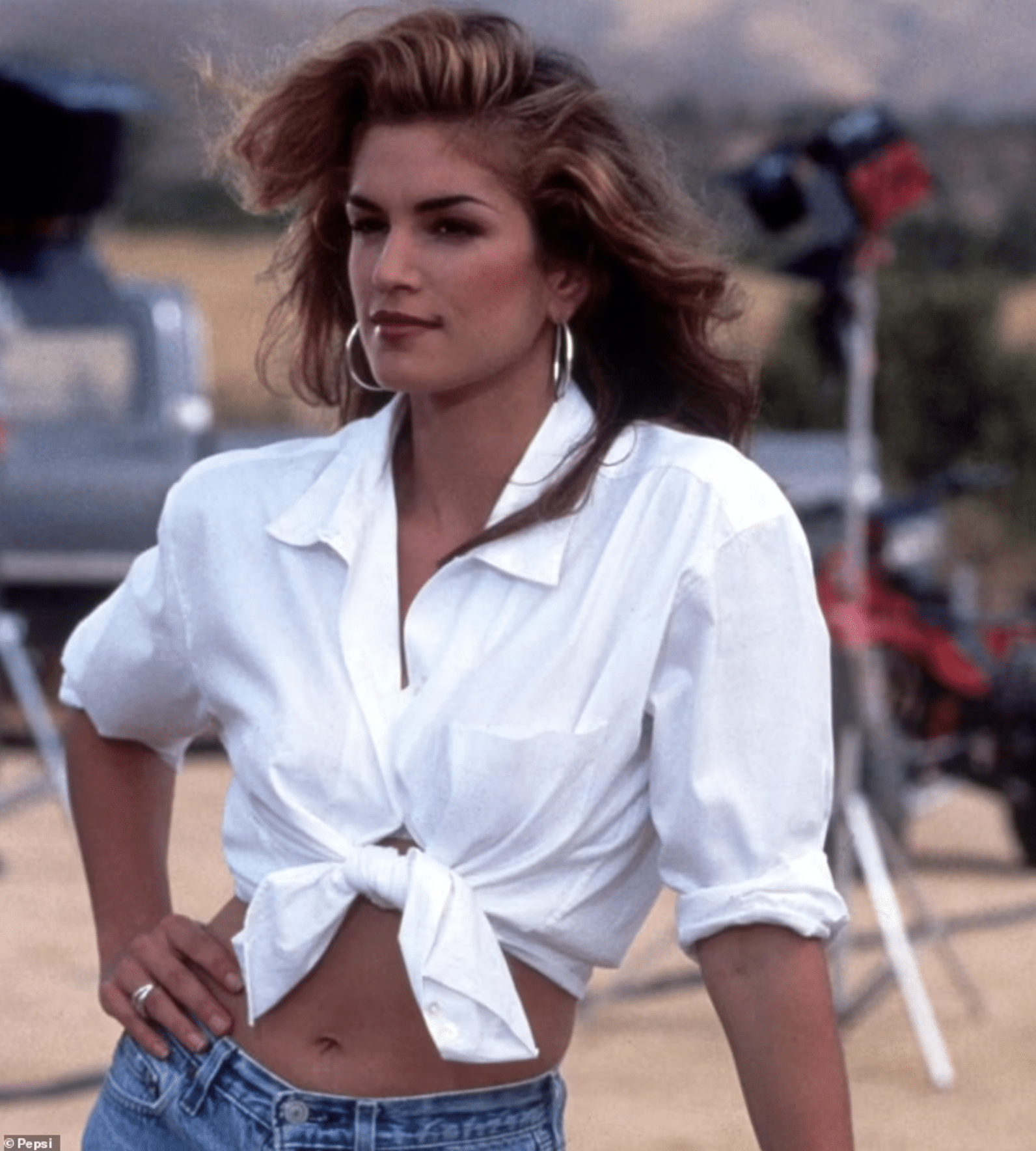
The winner? Some say that Cindy looked her very best in the original 1992 ad while others prefer a more mature Crawford
The winner? Some say that Cindy looked her very best in the original 1992 ad while others prefer a more mature Crawford
The original featured Crawford in a tank top and jean shorts – made from her own jeans she brought to the set that day – driving a Lamborghini and stopping at a rural gas station to buy a can of soda.
Two young boys in a nearby field can be seen watching on in awe and amazement as the beauty guzzles the can in one go.
‘It was one of those moments in my career that when I walked down the street, people were like, “Pepsi!” Or I’d be at a bar and people would send me over a Pepsi,’ Crawford said, laughing. ‘And it’s funny because during Halloween a lot of women will dress up as me in that commercial. It’s like an easy Halloween costume.’
In the 2018 ad she was with her son Presley Walker Gerber who was a teen at the time.
Crawford also appeared in an an ad for Diet Pepsi in 2002, where she drove to the same gas station, this time dressed in a tight white blouse and jean shorts, driving a white Jeep.
Crawford’s modeling talents have not only extended to her son – her daughter, Kaia Jordan Gerber, is also a top model.
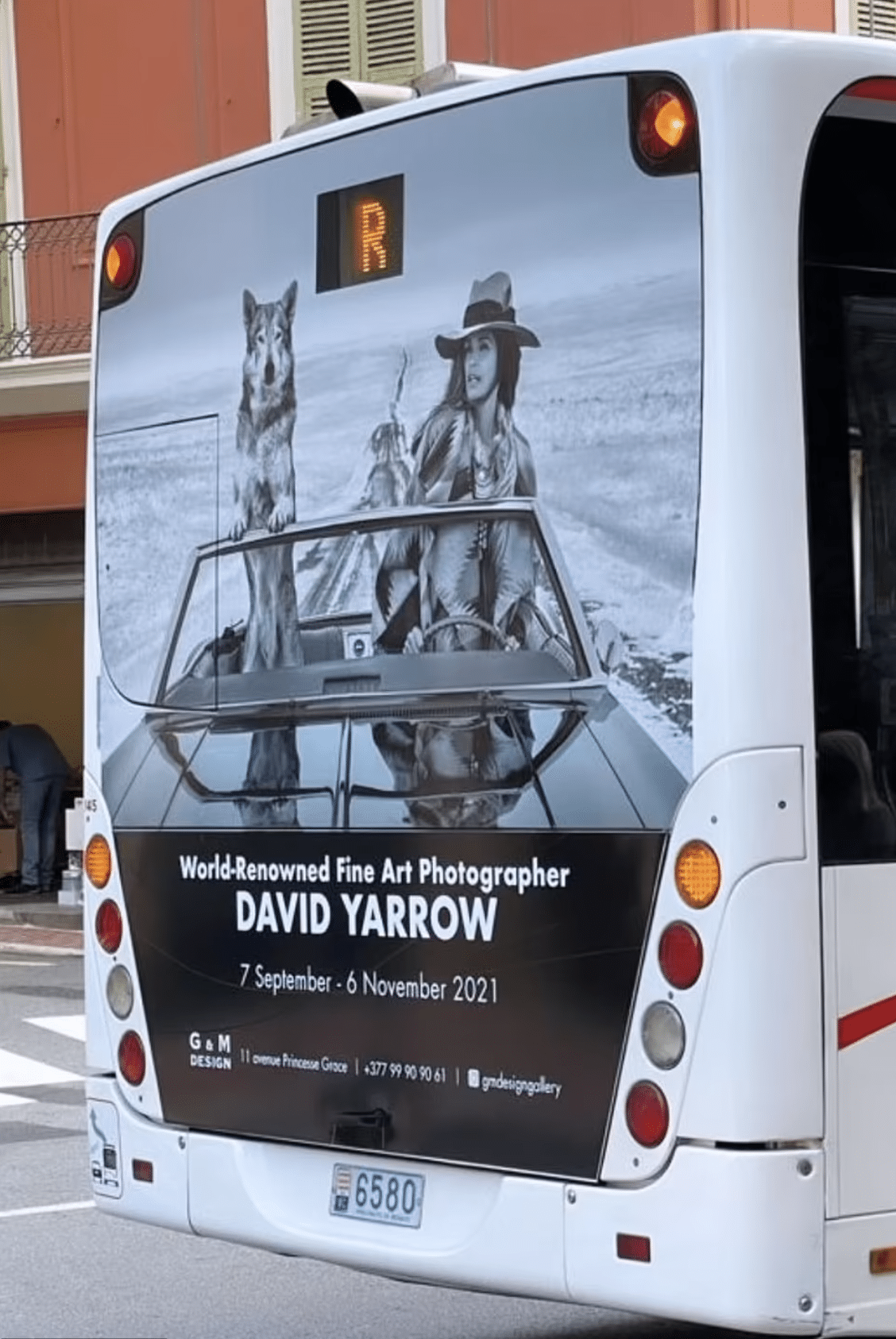
What are the symptoms of leukaemia in children?
Fatigue and pale skin – this is because leukaemia can cause anaemia which makes a child feel weak, tired and light-headed.
Infections and fever – children with leukaemia lack normal white blood cells which would normally help fight infection.
Rash – children may have small, dark spots that look like common rashes if the leukemia cells spread to the skin
Easy bruising or bleeding – this includes frequent nosebleeds, bleeding gums and bleeding a lot from small cuts.
Bone or joint pain – this is caused by a build up of leukaemia cells near the surface of the bone or inside the joint.
Swelling of the abdomen – leukaemia cells may collect in the liver and spleen causing them to enlarge.
Loss of appetite and weight loss – if the spleen and liver swell, they can press against the stomach causing loss of appetite.
Swollen lymph nodes – some leukaemias spread to the lymph nodes causing them to swell.
Source: American Cancer Society
The ad on the back of a bus: Here the ad i seen for the David Yarrow show which runs until November 6, 2021
Engine Of Change
The future of our planet and of humanity relies not just in lifting women up, but in giving them the opportunity to lead and to help invent a new economic era… because what’s good for women and girls, is good for Earth.
— Cristina Mittermeier
When we do this, we change the cycle. We build change. Seeds of change. Winds of change. Oceans of change. Climate change. Catalyst of change. Cristina Mittermeier is an engine of Change.
She is a Sony Artisan of Imagery, National Geographic Woman of Impact, founder of the International League of Conservation Photographers and co-founder of Sea Legacy, an organization combining decades of experience in conservation, photography, and communications, with the latest digital and social technologies, to build a healthy future for our oceans.
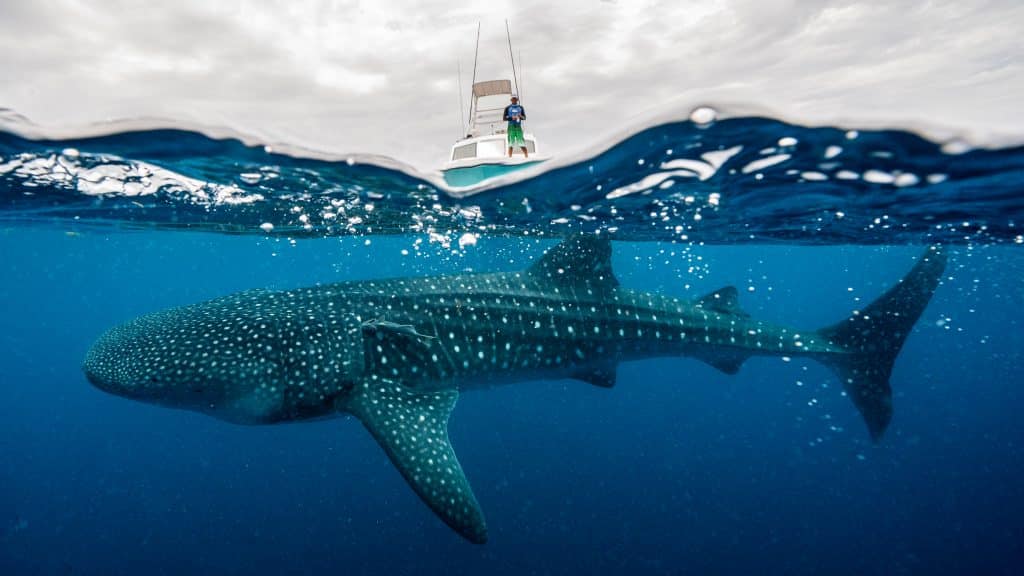
She is a woman whose influence has grown beyond her Mexico City roots as a marine biologist, artist, author and global champion for a sustainable earth. Her accomplishments fill an impossibly long list of environmental protections working in over 120 countries, from fisheries, biodiversity and the plight of indigenous peoples around the world to the support and education of young women and girls.
Mittermeier’s success as an activist and her ability to see into the needs of our world comes from a special place. All of her success and the mission that drives her comes from her ability to truly see the world and people as they are. Her provocative, insightful images come from a much deeper place when you understand Mittermeier’s focus behind the camera:
“There are some who believe that when you photograph a person, you capture an image of their soul. When photographing people, I have always focused on creating a photo that captures their essence as a human. My profound love for taking portraits is because they have such a deep narrative- a lifetime of stories within a single image.” ~ Cristina Mittermeier talks about “Lady With the Goose.”
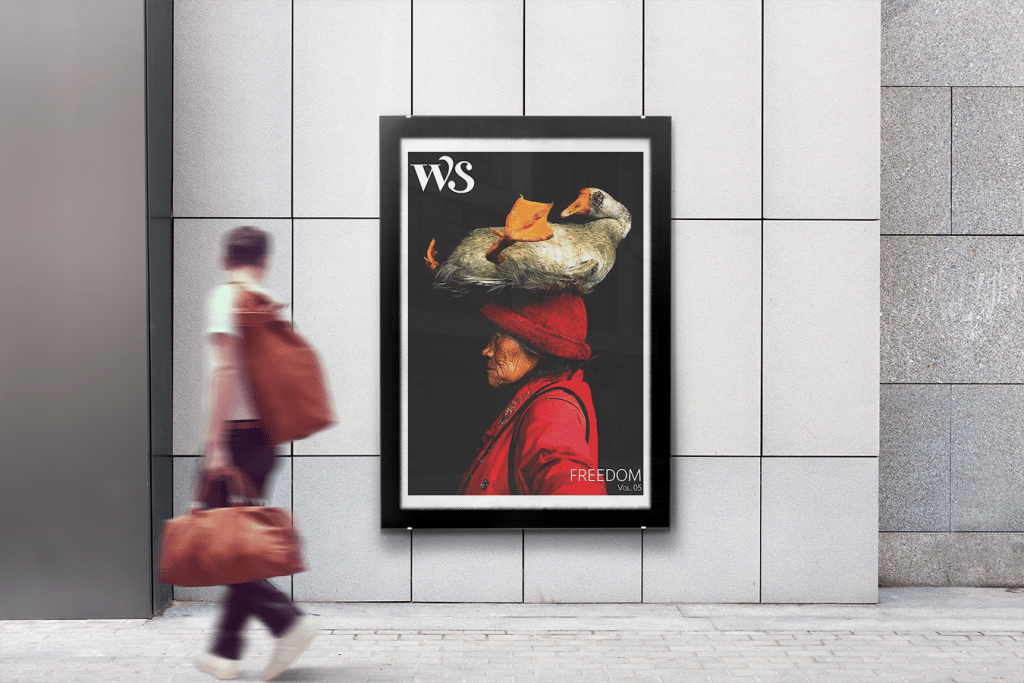
For International Women’s Day, German automobile manufacturer Mercedes-Benz chose Mittermeier as a central figure in their global initiative, She’s Mercedes. She’s Mercedes recognizes her ability to “inspire, connect and empower women in creating a dialogue that transcends cultures, industries and experience.” In doing so, Mittermeier’s conservation and photography honors the company’s storied traditions established, in part, by one of its pioneering founders, Bertha Benz.
Mercedes-Benz was founded on a dream to utilize technology in a way that would enhance the lives of people and the overall progress of humanity. As the wife of Karl Benz, Bertha was instrumental in supporting his vision of an engine-powered vehicle. But it was Bertha’s insistence that he use her dowry before the couple was married to save the fledgling company as it struggled financially, in the early stages. Further to this, she also suggested technical enhancements such as adding wire insulation and leather brake pads, during the initial creation of this new “horseless carriage.”
In fact, Bertha Benz was so committed to advancing progress as quickly as possible that she secretly took the first long-distance journey in the company’s inaugural motor car, traveling 105 km (65 miles) with her two teenage sons. Karl had no idea and during the rigorous drive, Bertha solved technical issues and proved to doubters that his 1888 invention was safe and reliable.
The confluence between Benz’s work and Mittermeier’s is obvious, more than one hundred years later. Mittermeier uses her camera, embarking on her own long-distance journeys to document the plight of our oceans and the effects of unsustainable living habits on our planet. As a trailblazing spokesperson for the damaging effects of climate change, it’s inspiring to see her recognized and supported by the very company that Bertha Benz helped establish.
Who would have thought that the connection between these two heroic women would run so deep? Benz ushered in mobility and progress, while Mittermeier advocates for cleaner technologies and progress away from petroleum-powered vehicles. This bold move by Mercedes-Benz recognizes Mittermeier’s influence as an advocate and spokesperson for the damaging effects of climate change. Mittermeier’s collaboration with the very company that Benz helped to establish speaks to the role that every company should play in combating the devastating effects of the petroleum industry.
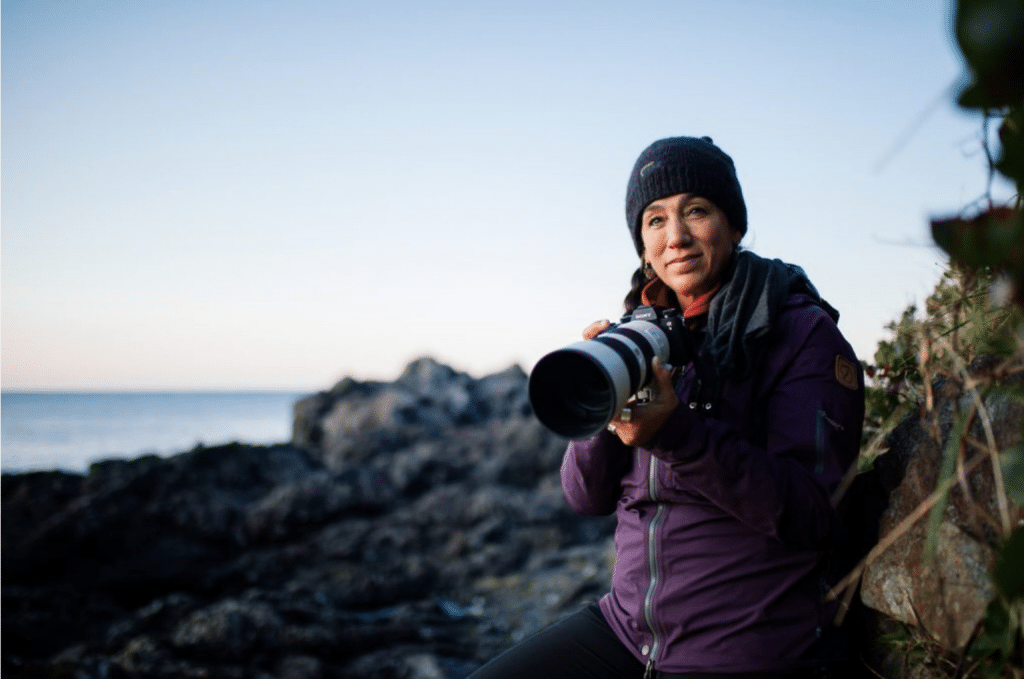
By the year 2022, the mission of Mercedes-Benz is carbon neutral production in all European plants (and worldwide by 2039) through renewable energy sources, such as wind power and other clean forms of energy. Once again, the automobile giant will need technological ingenuity and financial investments to change production methods, renovate factories, overhaul supply chains and develop new models of electric vehicles; all this while reducing production of the combustion engine within the next 20 years.
By promoting the use of hybrid-gas and electric powered cars, Cristina Mittermeier is driving change into the future. The theme for She’s Mercedes is Change Your Mindset. And that is what Mercedes-Benz has done. They have changed their mission and business model in accordance with their values.
“We have set a clear course to help prevent further acceleration of climate change,” the auto maker said in a statement, adding that the Paris climate accord is “more than an obligation — it’s our conviction.”
By using art as a tool, Mittermeier exposes the truths about the effects of climate change, our oceans, and the lifeblood of our existence. The oceans are under siege and not indestructible. They are the healing source of life and regulator of our climate. Oceans provide food and medicines for over seven billion people, yet they have become a holding tank for over 8 million metric tons of plastic – used once, and discarded. The implications of discarding a plastic water bottle or a single straw can no longer be ignored.
The extent of our negligent behavior can be seen, as Mittermeier suggests, as far as the polar regions and the coldest places on Earth. Antarctica is not immune to the immense threat of climate change. In addition, large commercial fisheries exploit foundation species, like a small crustacean called krill, a staple in the diet of whales, penguins and seals, and whose population dynamics are barely understood. A growing tourism destination, increasing pressure is put on fragile landscapes of the southern regions.
As consumer awareness about the harmful effects of gas emissions and the production industry that supports gas powered vehicle manufacturing, it is up to all of us to change the way we travel in the present and into the future. Our freedom to easily navigate our lives and explore our earth must acknowledge the footprint on our environment and the species that inhabits it.
“This year marks Antarctica’s 200th anniversary since it was first discovered and, unfortunately, it’s also the year where the highest temperatures in the ice continent’s history were recorded. This past February, temperatures soared to 20.75°C (69.3°F), alarming scientists and conservationists across the globe. World leaders are joining together to consider the establishment of three major MPAs (Marine Protected Areas) that would span across East Antarctica, the Antarctic Peninsula, and the Weddell Sea.
This would protect almost 1% of the ocean globally and approximately 4 million square kilometers. This is our chance to protect ecosystems to provide climate stability and to mitigate the effects of global warming on future generations. Think about that! At our fingertips is the creation of the greatest act of ocean conservation in the history of humanity, and it can all happen in a pandemic year!”
Mittermeier reminds us that 90% of the fish have disappeared from the oceans so every protection counts. “When I take stock of the challenges facing humanity and planet Earth, I cannot help but wonder, how can we aspire to solve massive global existential threats like climate change and inequality when half of our planet’s population is disenfranchised participate in the solutions?”
Women make up slightly more than half the global population. If we are serious about engaging every sentinel to save our great earth, we must ensure women have the opportunity to change the trajectory and find solutions.
Written By | Arica Hilton
Conservation in the Time of Corona
The new decade has brought with it some unexpected challenges, but those same obstacles have given us an opportunity to focus on reaching out to our online community, and to explore new methods of digital story telling.
At this time when science is critical for our survival and art is necessary for our sanity, the conservation photography of Paul Nicklen and Cristina Mittermeier is the perfect union of these two complementary paradigms. Hilton Asmus Contemporary couldn’t be representing a more inspirational and dedicated pair of humans.
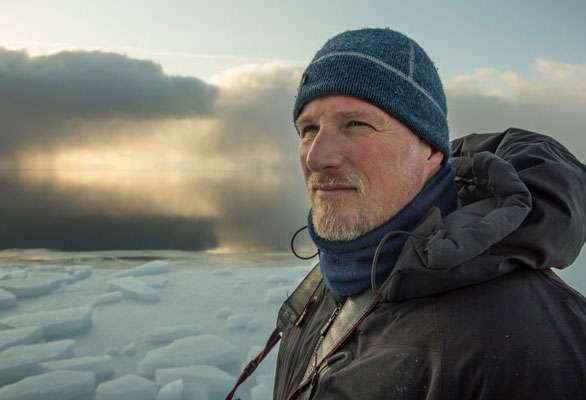
Paul Nicklen is an acclaimed National Geographic photographer, filmmaker, and marine biologist who has spent the last twenty years documenting the natural beauty of our planet in an effort to illustrate the plights of critical species and their fragile ecosystems, while advocating for their protection. As a National Geographic assignment photographer, he is particularly famous for his awe-inspiring images of polar wilderness regions and the unique animals that call these harsh and rugged habitats home. Nicklen’s sensitive and evocative imagery has garnered many of the highest awards given to any photographer in his field, including the BBC Wildlife Photographer of the Year and the prestigious World Press Photo for Photojournalism.
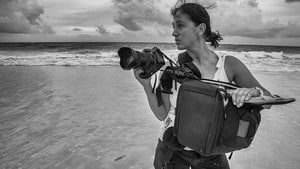
Cristina Mittermeier is a marine biologist, photographer, writer, and conservationist. Fifteen years ago, she founded the prestigious International League of Conservation Photographers (ILCP) to provide a platform for photographers covering environmental issues. She primarily specializes in creating images related to ocean conservation and indigenous peoples. Mittermeier is recognized as one of the World’s Top 40 Most Influential Outdoor Photographers, was the recipient of Smithsonian Conservation Photographer of the Year Award in 2010, and was named one of National Geographic’s 2018 Adventurers of the Year. Cristina’s work has appeared in hundreds of publications, including National Geographic Magazine, McLean’s and TIME.
Together, Cristina and Paul founded SeaLegacy in 2014. The goal of this Canadian nonprofit is to “bring together the world’s best photographers, conservationists, scientists, storytellers and strategists to lead a bold new movement to engage one billion people in ocean conservation.” SeaLegacy’s three-pronged approach of leading expeditions, fueling campaigns, and implementing solutions is united by a focus on extraordinary visual storytelling. “I’m fortunate to be able to lead some of the world’s best photographers and film makers to the farthest corners of our oceans,” says Paul. “It’s our job to bring the oceans to you.” SeaLegacy uses its massive media footprint of over six million followers to rally global support for projects that invest in community-centered solutions that help build healthy and abundant marine ecosystems. As Cristina explains, “Extraordinary opportunities exist to restore and sustainably develop our oceans in order to protect them and sustain all life on this planet.”
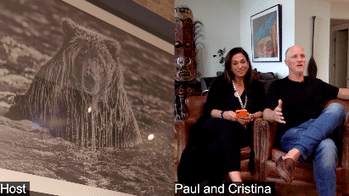
It’s a privilege for us at Hilton Asmus Contemporary to represent the gorgeous work of this truly visionary team. Paul and Cristina were kind enough to join us earlier this week from their home in Vancouver for the virtual launch of their show at our gallery. It was enlightening to hear firsthand about their mission at SeaLegacy, and a pleasure to get a peak into their exciting and unique lives. Two nights in a row – April 2nd and 3rd – they transported us all over the planet with their stories. Paul closed out the live Instagram feed last night by regaling us with a tale of a Grizzly bear he called Morris who chose to eat his salmon dinner right next to Paul while he sipped on a nightcap. These lively and personal background narratives bring the photos to life.
Once it’s safe to start going back to our regular activities, we can’t wait to invite everyone to come to the gallery and enjoy each one of these stunning images. When you view their photographs, they pull you in and hold your attention, making you yearn to know everything about the subject. The color photos will be a feast for your eyes, while the black and whites will mesmerize you with their details. Each composition is so saturated with life that you’ll swear you can hear the ice crunching under your feet, and feel the humid air of the tropics on your skin.
We have dubbed 2020 our Year of Conservation, and the tireless efforts put forth by Paul and Cristina to protect our priceless natural wonders, embody this theme to perfection. Even though we may currently be apart, their art excels at bringing us together, and reminding us how important it is to value and protect every ecosystem on this beautiful planet we are endlessly lucky to call home.
Written By | Alex Rose
Photographer David Yarrow on the Inspiration Behind His New ‘Wild West’ Series Starring Cindy Crawford and Cara Delevingne
Yarrow traveled to Montana and Wyoming to create these quintessentially American images.
British photographer and conservationist David Yarrow is celebrated for his black-and-white photos of far-flung territories, endangered landscapes, and nature’s most majestic creatures. This fall, after a long quarantine, the photographer set off for Wyoming and Montana to shoot his new series “The Wild West.” Headlined by supermodels Cindy Crawford and Cara Delevingne, the series captures quintessentially American scenes from the cross-country road trip, which culminated at a Western saloon. “The Wild West” series also features Chief John Spotted Tail, of the Lakota tribe, who appears self-styled in his images.
The new images—along with many of Yarrow’s iconic works from earlier series—are currently on view at Chicago’s Hilton | Asmus Contemporary. A portion of the profits from sales will be go to benefit charities and organizations supported by Yarrow and his models.
Below, Yarrow shares his inspiration behind a few of his new photographs:
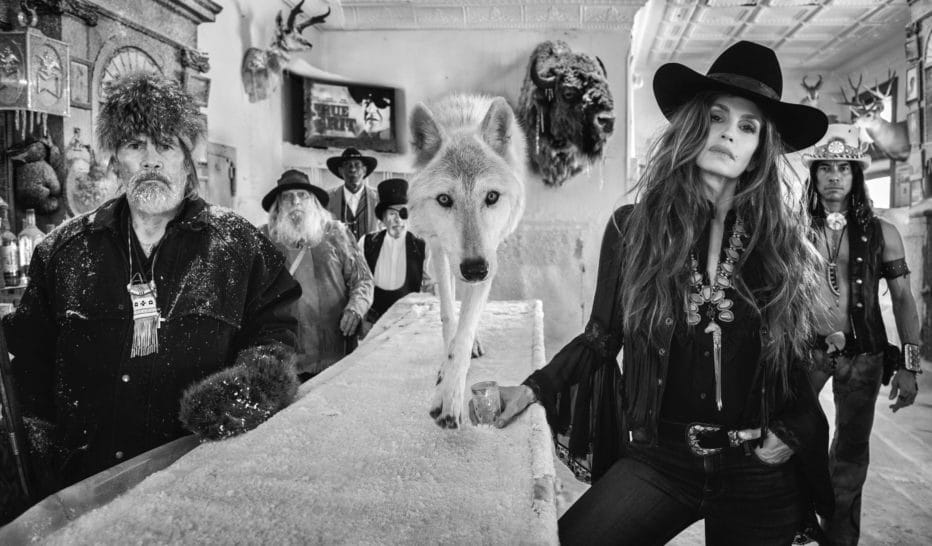
“We have all, at one time or another, entered a bar, and immediately felt out of place. At the most extreme level this can evoke a sense of trespassing. This was very much the narrative behind this photograph. To be greeted by an overtly territorial crew with menace and attitude. But, for the story to work, two things had to coalesce as—the characters and the interior. I like playing with the cold, it adds a visceral layer to the story and in this case, it hints at an outpost on the final frontier. Surely the further off the beaten track we travel, the greater the chance of being the outsider. This is a frame that exhausts every inch available in the camera and that was my intent. There were so many characters I wanted to include, but I was also reluctant to lose the mood of the frozen saloon…. Our key asset was, of course, Cindy Crawford, and she had to have sovereignty of the joint. She can play a badass very well and that was her ascribed role.”
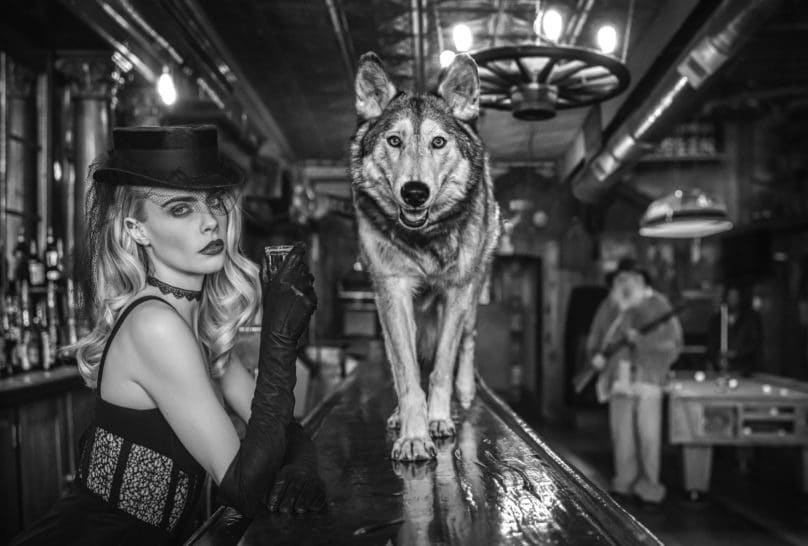
“The Pioneer bar in Virginia City has offered so much to us over the years and we are acutely conscious not to overplay our hand here. After all, there are many other weathered saloons in the West. We don’t want to be repetitive in our story telling…The Pioneer is emphatically the best bar known to us. It has depth and the wagon wheel on the ceiling is ideally positioned. To bring such a celebrated and relevant woman as Cara to Montana is fresh ground. Put her in front of the Eiffel Tower and it is a new look on the Eiffel Tower. I can’t think of any other woman in the world I would prefer to play this role. These are not easy images to execute as there is such limited light. Depth of field and shutter speeds are therefore compromised. Cara would always be sharp—that was easy—then we had to hope for some luck elsewhere. Cameras have improved so much over the years in terms of ability to work in low light. I could not have done this 10 years ago. But you are pushing the camera right to the edge of its capability.”
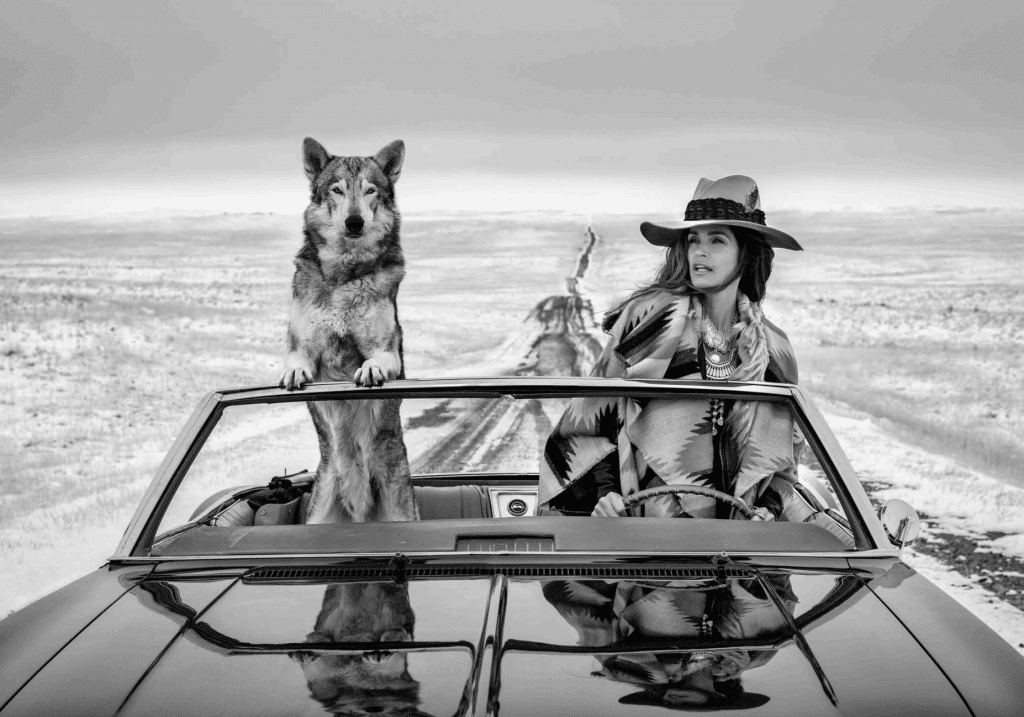
“Once we found the caterpillar road that dissects this picture, I knew that we had the canvas on which to continue our road series that started in 2018… The only traffic was the occasional oil worker or perhaps someone who was totally lost… The sense of place is palpable. This is the America that so many know and love, with its long roads running to the horizon with either side exuding a simple sense of calm and solitude. No other country in the world offers road trips as visually rewarding as America and they are integral to the fabric of the American dream. The snowfall the previous night added another layer to the narrative both on the road itself and on the prairies. We were lucky that the snow stopped and the light picked up. It adds warmth to an image already glowing with positivity and joy. Willie Nelson was surely singing “On the Road Again” on the car radio with the volume turned up to the maximum level.”
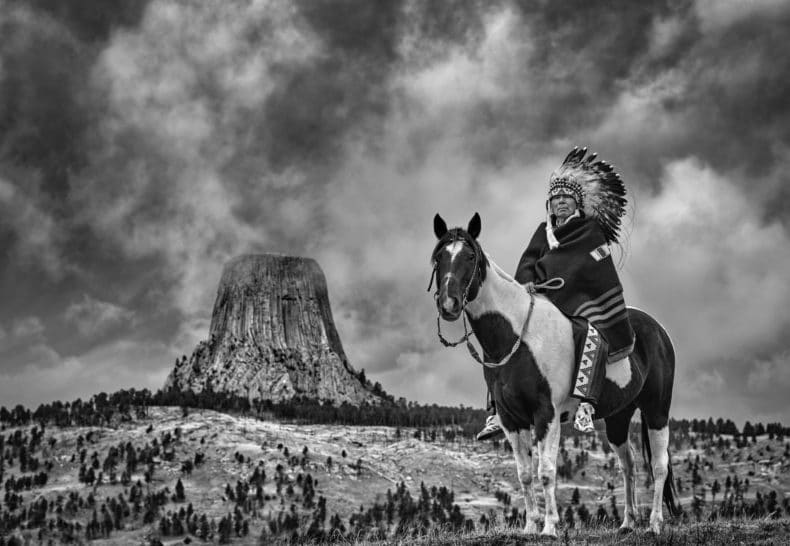
“The senior Elder of the fabled Lakota tribe is Chief John Spotted Tail. We spent two days with him in northern Wyoming and he was so excited to wear the headpiece that only the most senior Native American chiefs like him can wear. His attire was emphatically his decision, not ours. Their heritage is integral to their souls. The ground in front of Devils Tower has film history. It is, of course, where Spielberg shot Close Encounters of a Third Kind immediately after the release of Jaws in 1975. More poignantly, it is sacred land for Native Americans, and, at dawn, before our early morning shoot, John and his wife, Tamara Stands and Looks Back, spent some time there praying. At around 8:30 am, the low hanging clouds lifted above the iconic geographical landmark and shafts of light lit up our canvas. We had our moment. Later that day, when I showed Chief John Spotted Tail this image, he shed a tear and I am proud to admit I did too. It was one of the most privileged days I have ever had in the field.”
David Yarrow’s “The Wild West” series is on view at Hilton| Asmus Contemporary through June 2021.
Written By | Artnet
Fragile beauty
How conservation photographer Cristina Mittermeier uses her work to protect the oceans.
The pictures by photographer Cristina Mittermeier show how fragile our planet is. They show the beauty and, at the same time, the transience of nature. Despite all the challenges, Cristina is certain: it is not too late – we can save our planet if we act together now. We visited the marine biologist on board our first all-electric vehicle, the EQC. In her chosen home on Vancouver Island, we talked to her about how she uses her passion for strong stories to make the earth a better place – and how she was the first “conservation photographer” in the world to succeed in a male-dominated profession.
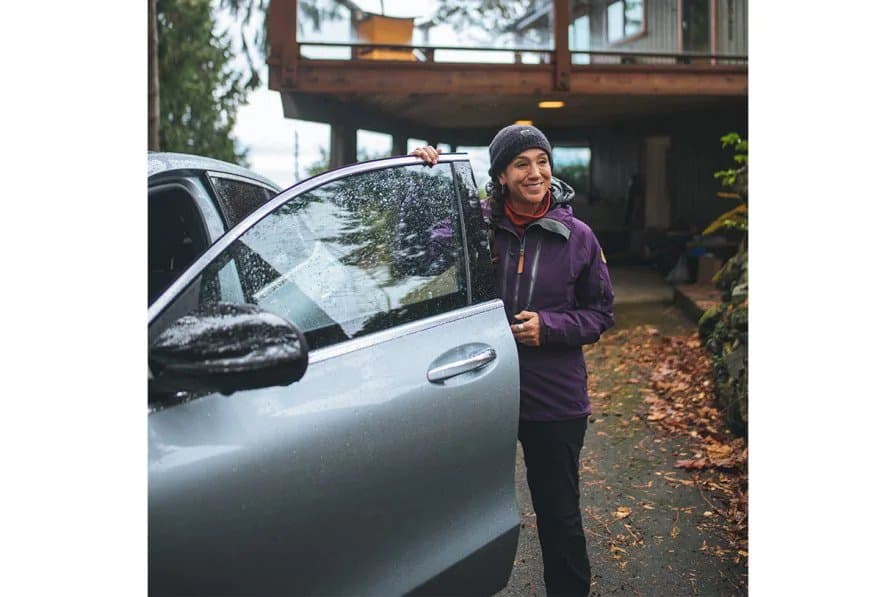
Listening to Cristina Mittermeier talk about nature, there is no need to ask why she has made Vancouver Island the centre of her life. The Pacific island is a natural wonder, impressing with picturesque fjords, rainforests and fascinating storms. One could almost use this natural phenomenon as a metaphor to describe Cristina’s captivating personality: her non-conformity, her courage and her enduring passion for what has helped her to succeed in an industry that is still predominantly male. How does that work? “Don’t listen to the voices in your head telling you that your dream is not for girls. That you are not strong enough, brave enough or smart enough. Instead, imagine walking those voices to the edge of a cliff and throwing them over. It takes a lot of courage to take the more difficult path; do it anyway; defy the norm and be an example to others.” Cristina is using the fact of being a woman to her advantage. She has managed to turn perceived weaknesses into her secret weapon.
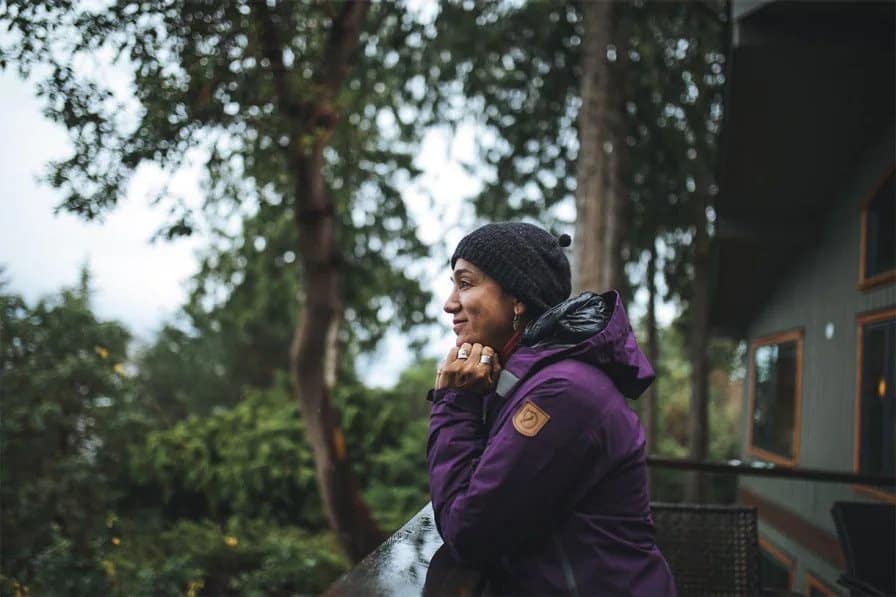
We visit Cristina in her cosy house right on the Bay of Georgia, where she lives with her husband Paul Nicklen and their two dogs. Spread out on the living room table are some pictures, which the photographer is currently signing. Paul Nicklen is also a nature photographer and her “life and adventure partner,” Mittermeier tells. In addition to their shared love of photography, the two are united by their desire to protect the environment. Above all: the oceans. “The sea is full of life, full of wonder, so beautiful and wild. But its beauty is fragile. If we don’t protect it, it will vanish.”
This is one of the reasons why Mittermeier sees her work as political. Her photography is her tool; the social networks are her reach enhancer. Magazines such as National Geographic and TIME print her pictures and on Instagram 1.3 million people follow the work of the 53-year-old. During a peaceful trip in the virtually noiseless and locally emission-free EQC through the pristine nature of Vancouver Island, Cristina tells us more about the philosophy of her daily work, which she describes much more as a calling: “Each of my pictures tells a story – the story of the problems that threaten our planet and our oceans.” This is why she describes herself not as a nature photographer but as an environmental photographer – a “conservation photographer” by all means. She has significantly coined the term. Conservation stands for preserving. This is exactly what Mittermeier wants to do: help preserve the planet – and motivate others to do the same. How did she manage to live her dream? “Unknowingly, I made all my important life decisions based on the Japanese philosophy Ikigai (‘finding the meaning of life’). Ikigai calls for us to pursue the things we love, which are the things we have a talent for, which are the things we can earn a living from – and which are the things that make our world a better place.”
Cristina Mittermeier prefers to take her photos where it is particularly cold and wet: under water. However, only about ten years ago Mittermeier came to underwater photography. “I am the best example of how it is never too late to pursue your dreams,” she laughs. Before that, Cristina photographed rather casually – until a special turning point many years ago. At that time, she accompanied the father of her children, a biological anthropologist, to the tropical regions of the world. While he set off on expeditions, she stayed behind in the surrounding villages. She began to portray the inhabitants in the villages – mostly women and children of indigenous tribes. Not in the service of science, but for emotional reasons. Her aim: to capture the perspective of disenfranchised and mostly invisible women. When the photos were printed, she noticed that they make the viewers think. “As a biologist, I was committed to environmental protection already. But I noticed that people react very differently to my photos than to my studies.”
Since then, she has had a dream – and through her work, she is calling for the protection of our unique planet. “I love that my job is my entire life. I get up every morning knowing that I’m contributing to a better world with what I love most – using my stories and images to help protect nature.”
In Memoriam: Terry O’Neill
News
NOVEMBER 18, 2019 | TERRY O’NEILL
New York Times: By Neil Genzlinger
On an early assignment he shot a new group called the Beatles. He went on to photograph, among many others, Faye Dunaway — whom he later married.
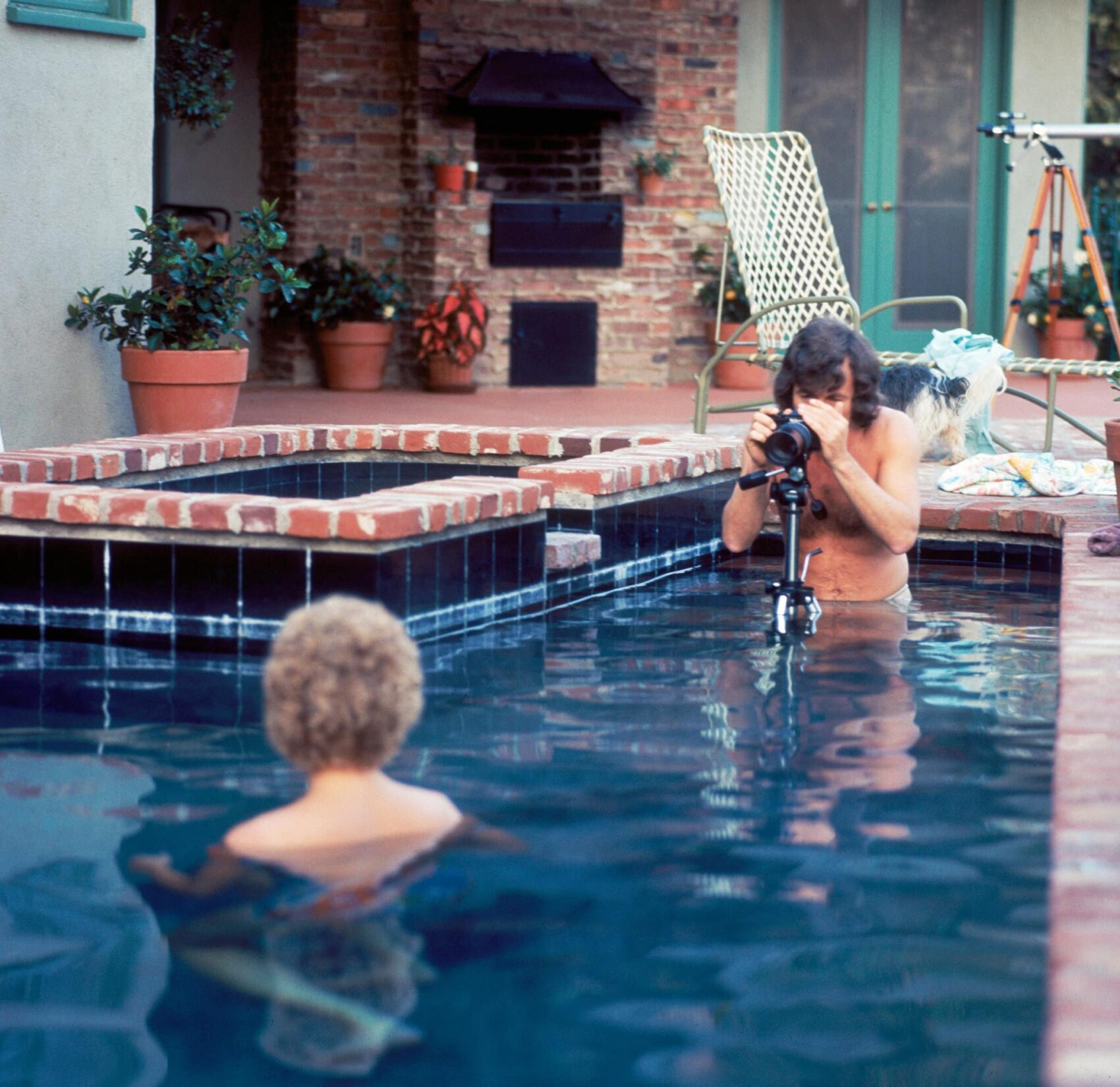
Terry O’Neill, who as a novice photographer found himself shooting pictures of an up-and-coming group called the Beatles and never looked back, spending a lifetime capturing memorable images of musicians, movie stars and other celebrity gods of the age, died on Saturday at his home in London. He was 81.
Carrie Kania, creative director of Iconic Images, the London agency that represents him, said the cause was cancer.
Mr. O’Neill was the photographer of choice for a wide array of the stars of the 1960s and beyond. He photographed not only the Beatles and the Rolling Stones, but also Frank Sinatra; not only classic Hollywood actresses like Audrey Hepburn, but also more recent big-screen favorites like Nicole Kidman. Winston Churchill, Nelson Mandela and other prominent politicians turned up in his lens as well.

Mr. O’Neill had a way with putting famous people at ease and became friends with many of those he photographed. For a time in the 1980s he was married to Faye Dunaway, having taken one of his best-known images of her in 1977 on the morning after she won an Oscar for her performance in “Network.”
That picture — Ms. Dunaway lounging beside the pool at the Beverly Hills Hotel — and the story behind it show Mr. O’Neill’s preference for the casual shot over the stiff portrait, a signature of his work. People magazine had assigned him to get a photograph of Ms. Dunaway, assuming she would win the Oscar.
“While we were doing the pictures, I said to her: ‘I’ve been to the Oscars before. If you win, they always take the same pictures of you receiving the statue in the press room,’” Mr. O’Neill told New York magazine’s website The Cut in 2015. “I knew that wasn’t the real story — the real story is the next day, when they realize suddenly they’re getting all these offers to do films, their value goes from $100,000 to $10 million, and they’re just sort of stunned. I wanted to capture that.”
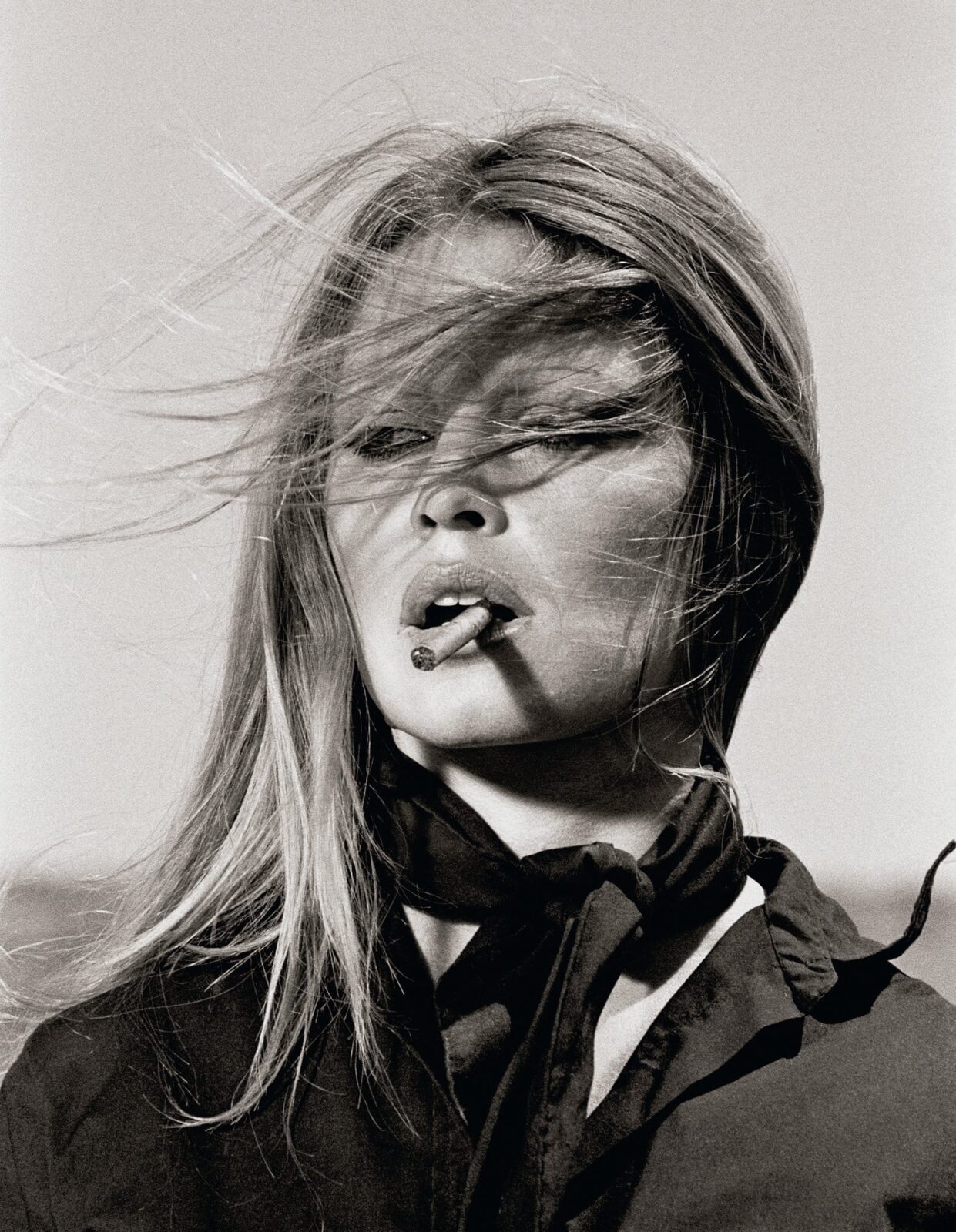
Another well-known O’Neill image was of Brigitte Bardot, captured in 1971 during an unguarded moment while she was on location in Spain, cigarette in her mouth, windblown strands of hair across her face.
“That was the last frame in a roll of 35 millimeter,” he told The Irish Examiner in 2013. “The wind blew and I took the picture.”
“I only had one crack at it,” he added, “and it turned out to be a stunner.”
Among Mr. O’Neill’s favorite subjects was Elton John; the image on the cover of his “Greatest Hits” (1974), of Mr. John in a white suit and oversize glasses, is his. Sinatra and David Bowie, two decidedly different singers, were also photographed repeatedly by Mr. O’Neill.
“I didn’t like his voice,” Mr. O’Neill confessed of Bowie in an interview last year with The Scotsman, “because I’m a jazz fan, a blues fan, and not really into that type of music. But he was a fascinating guy to work with.”
Present-day stars and celebrities, he found, were not so fascinating, lacking the magnetism and larger-than-life quality of the subjects of his photographic heyday.
“I don’t want to photograph anyone anymore,” he told The Scotsman.
“I think,” he added, “I was born at a time where I had the best of the best to shoot.”
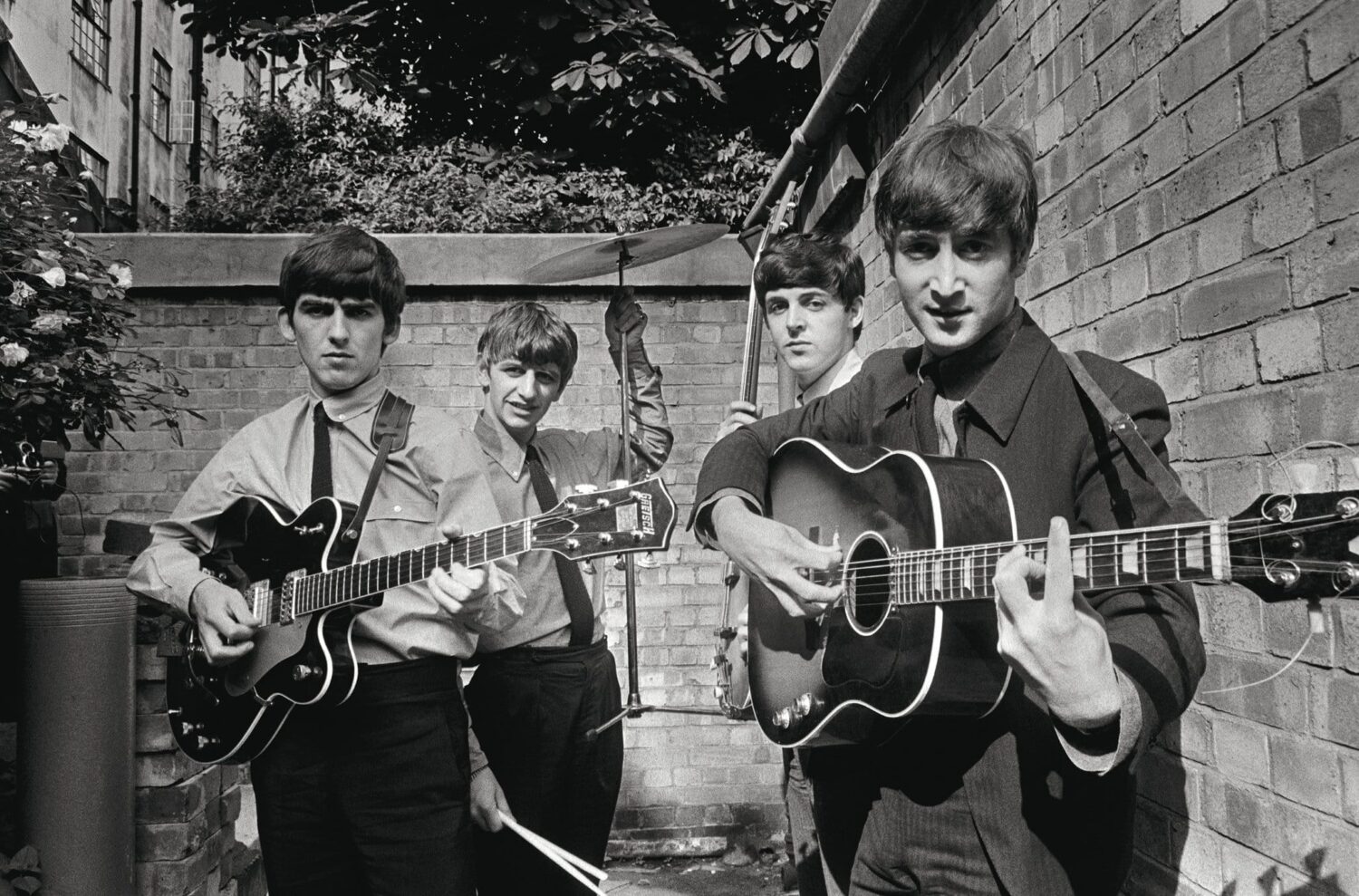
Terence Patrick O’Neill was born on July 30, 1938, in London. His father, Leonard, was a foreman at a Ford plant, and his mother, Josephine, was a homemaker.
He left school at 14, and several years later, aiming to become a jazz drummer, he sought a job as a flight attendant with British Overseas Airways Corporation, the forerunner of British Airways. He hoped to try jazz clubs in New York during layovers. Instead, the airline placed him in a photography unit based at Heathrow Airport.
As he told the story later, one photograph started him on his career path. Part of his job was to take pictures of people arriving and departing. He shot one of a well-dressed napping man in a bowler hat surrounded by African chieftains in traditional regalia. The man in the hat was the politician R.A. Butler, who was home secretary at the time, and the picture found its way to the newspapers, and editors on Fleet Street took notice.
“They said, ‘You’ve got an eye’, but I had no idea,” he told The Scotsman. “I said, ‘I don’t know what I’m doing,’ but they said, ‘Just keep doing it, we’ll train you,’ and they did. They turned me into a photographer.”
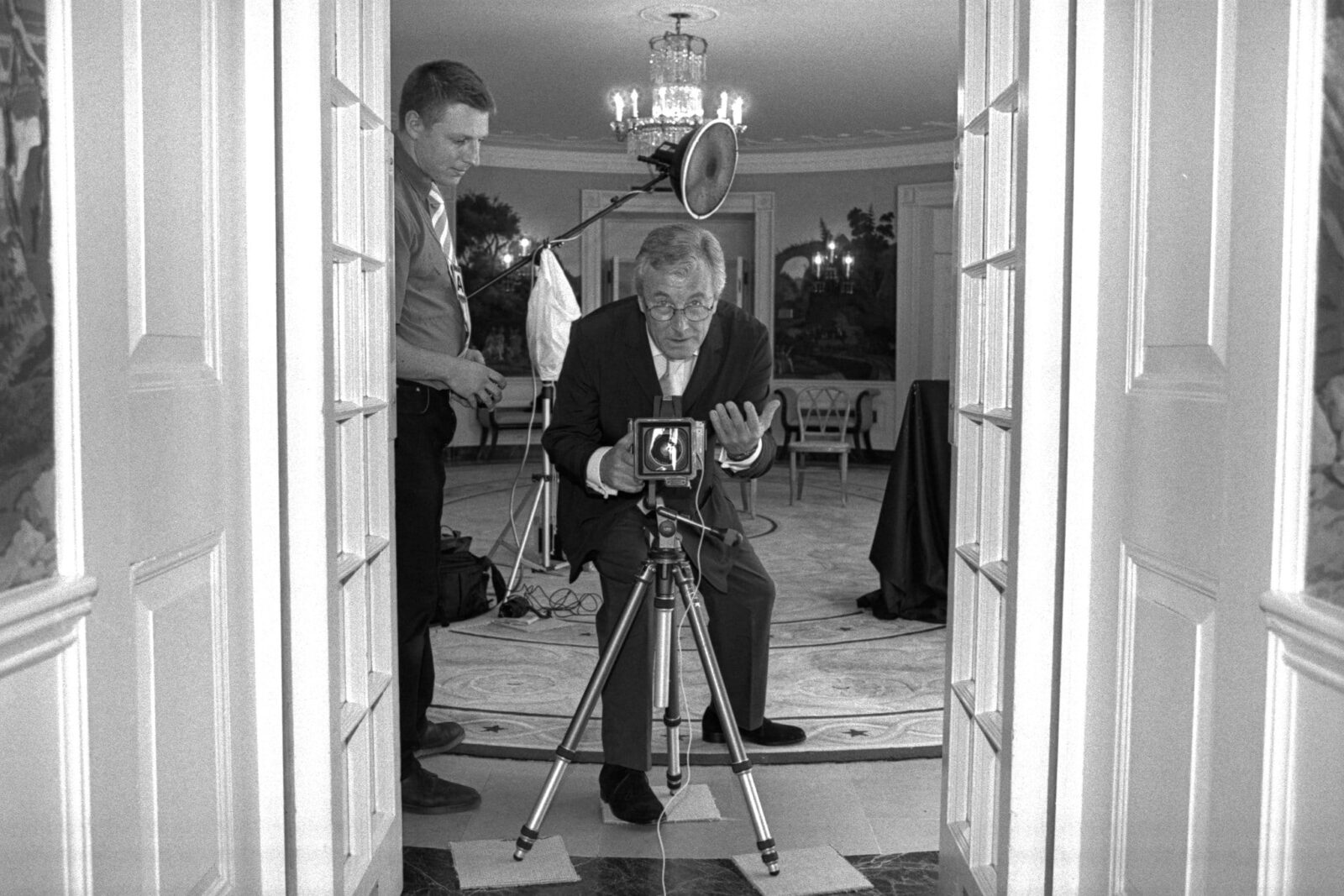
He worked for The Daily Sketch, a tabloid newspaper, for a time, then struck out on his own. An early assignment was to photograph the Beatles in 1963 just as they were breaking big in England. The Stones soon called asking for his services.
He continued to photograph both groups and their individual members as they rocketed to fame. He was still photographing Paul McCartney some four decades later. Elvis Presley, Janis Joplin, Tom Jones, Boy George, Led Zeppelin, Joan Baez and countless other musicians also turn up in his archive.
Mr. O’Neill married the actress Vera Day in 1963; they divorced in 1981. He and Ms. Dunaway were married from 1982 to 1987. In 2001 he married Laraine Ashton, founder of a modeling agency, with whom he had had a long relationship. She survives him, as do two children from his first marriage, Sarah and Keegan; a son from his second marriage, Liam; a stepson, Claude; and three grandchildren.
In 2018 Mr. O’Neill talked to The Scotsman about his collection of millions of negatives.
“I look back at all the pictures and I can’t believe the life I’ve had,” he said. “They’re all memories for me.”


